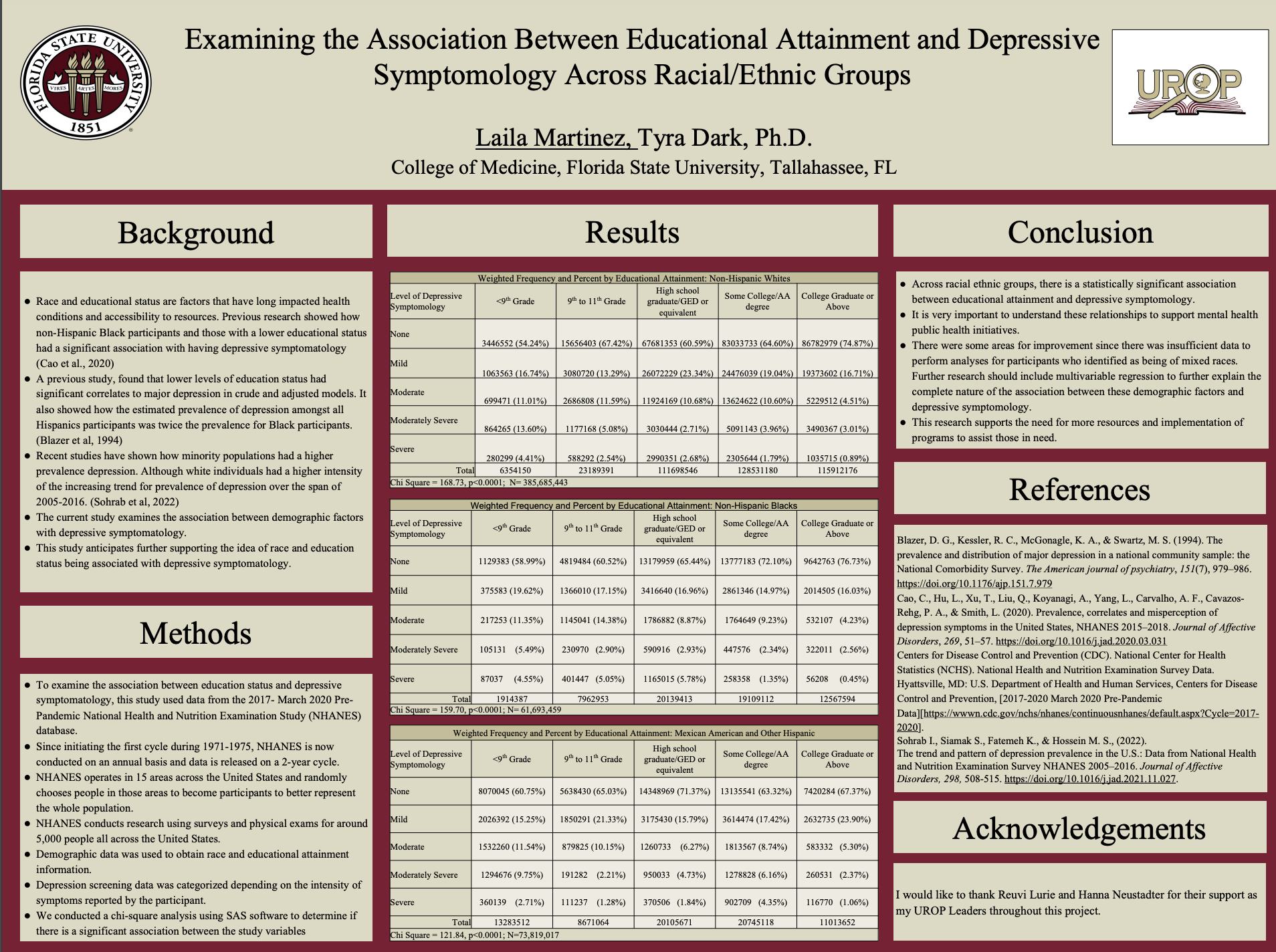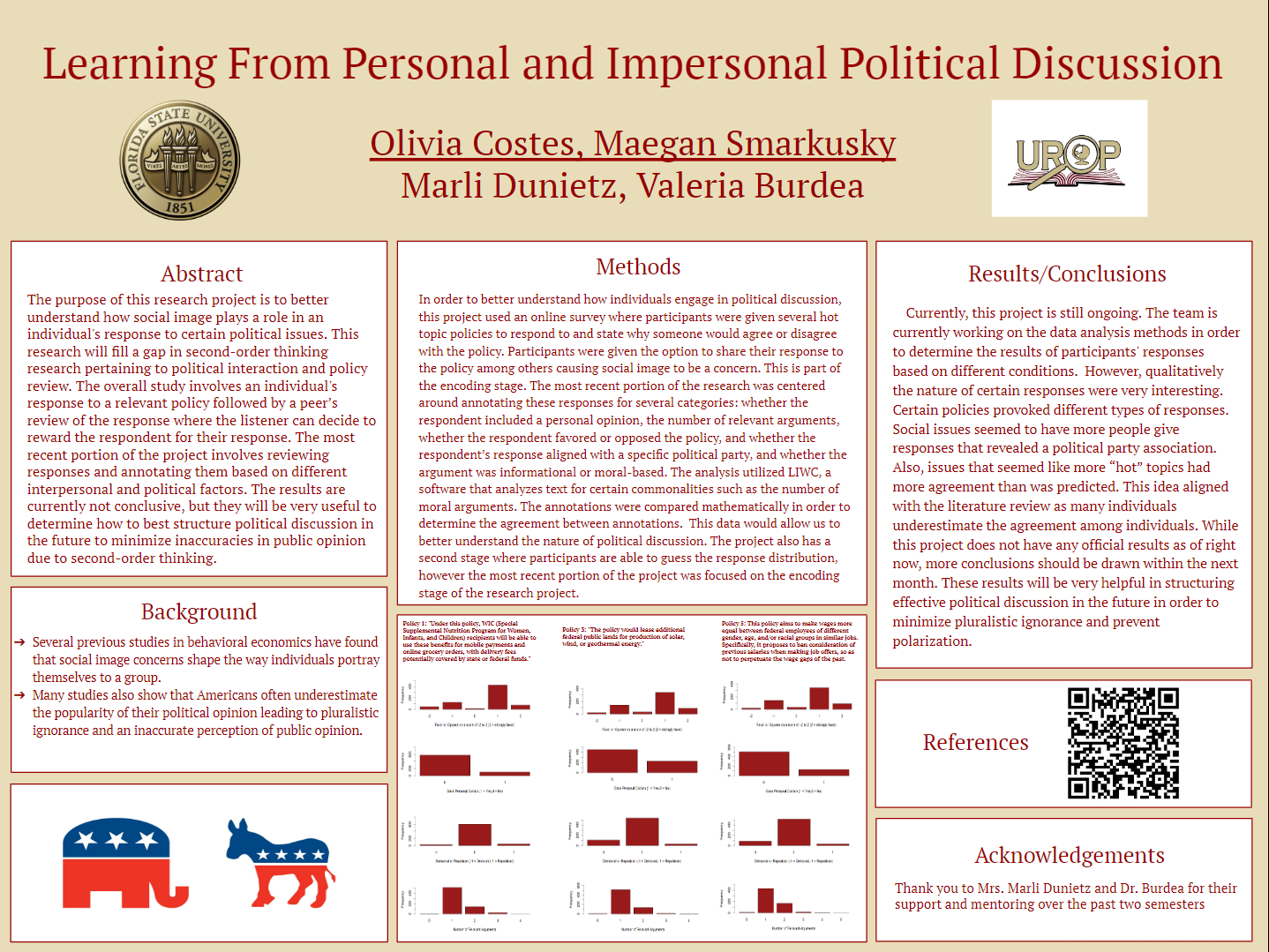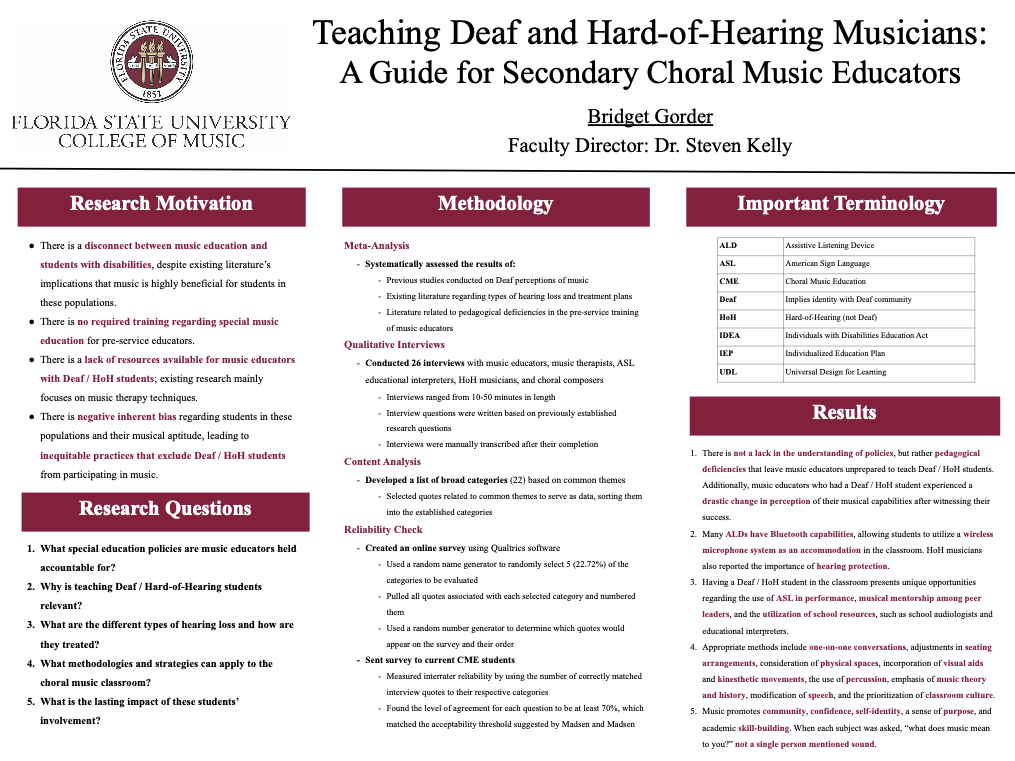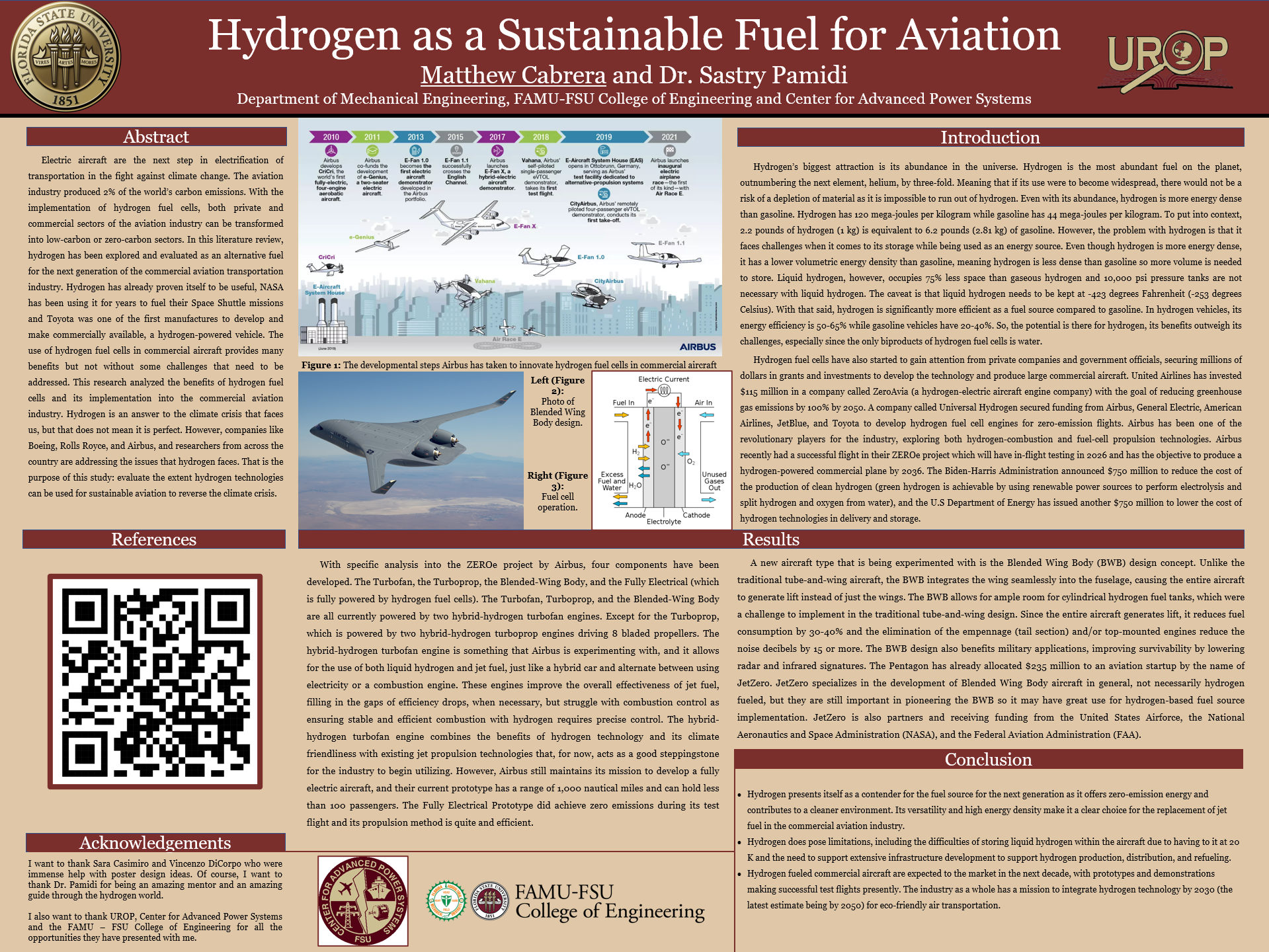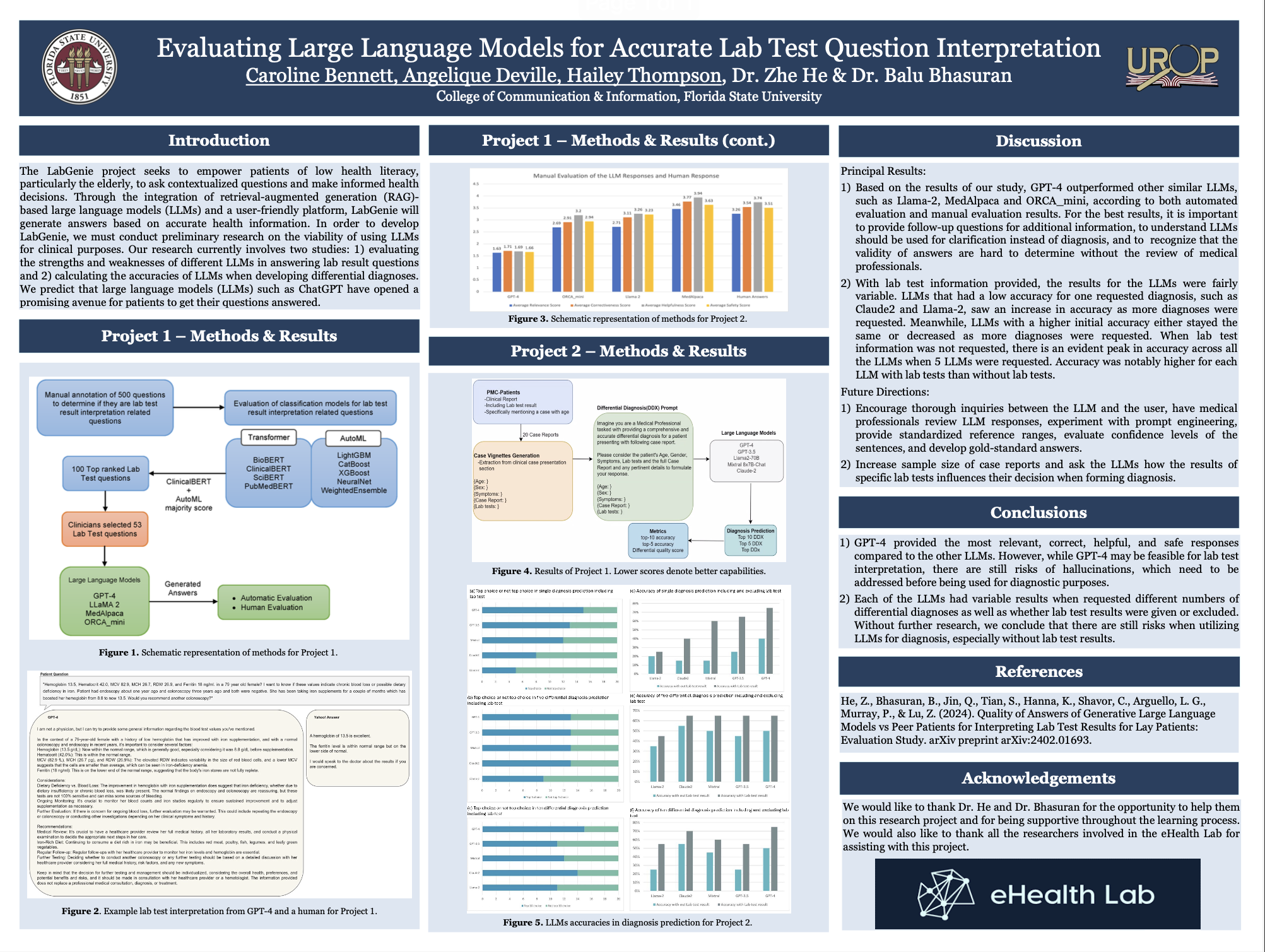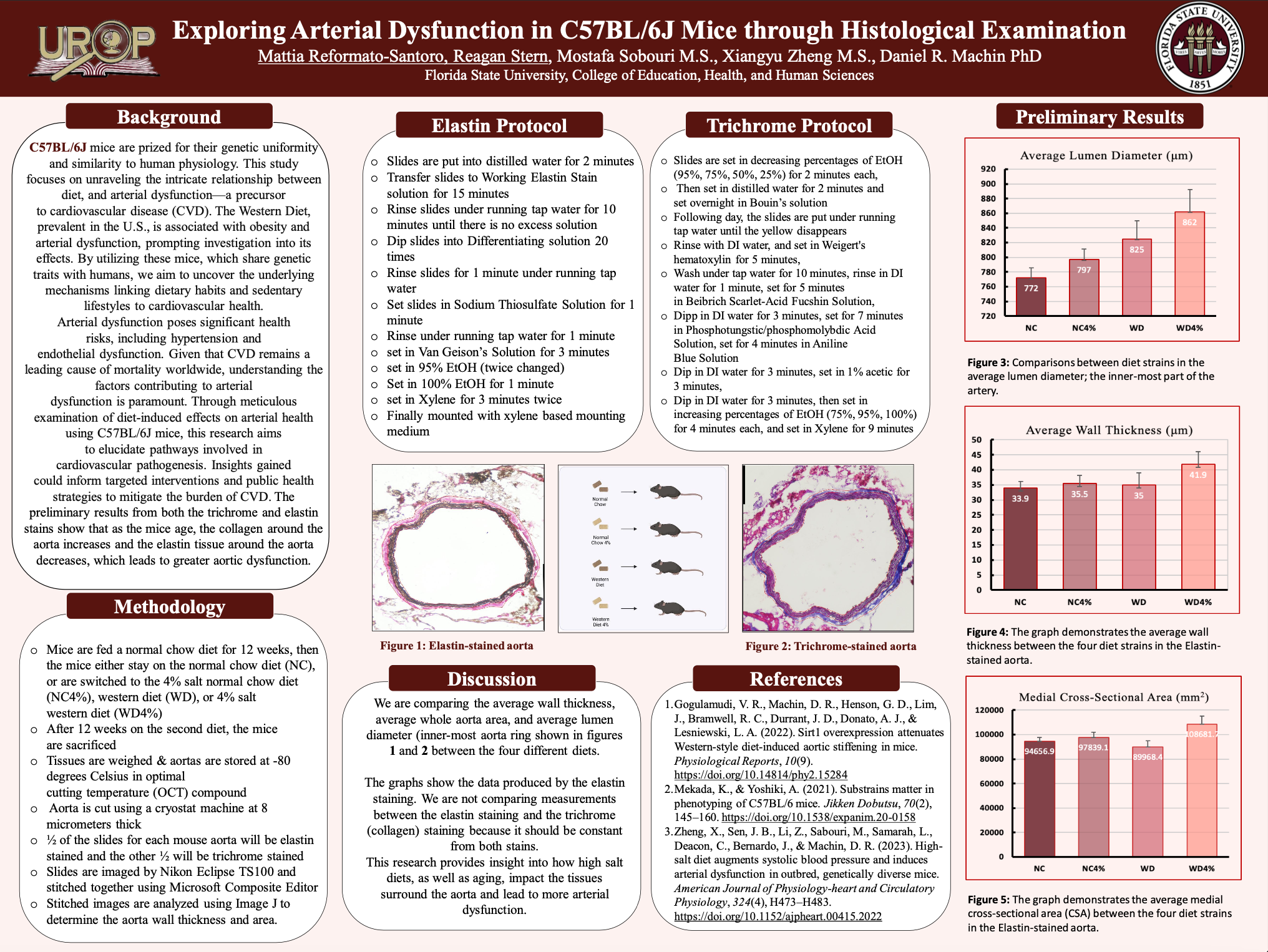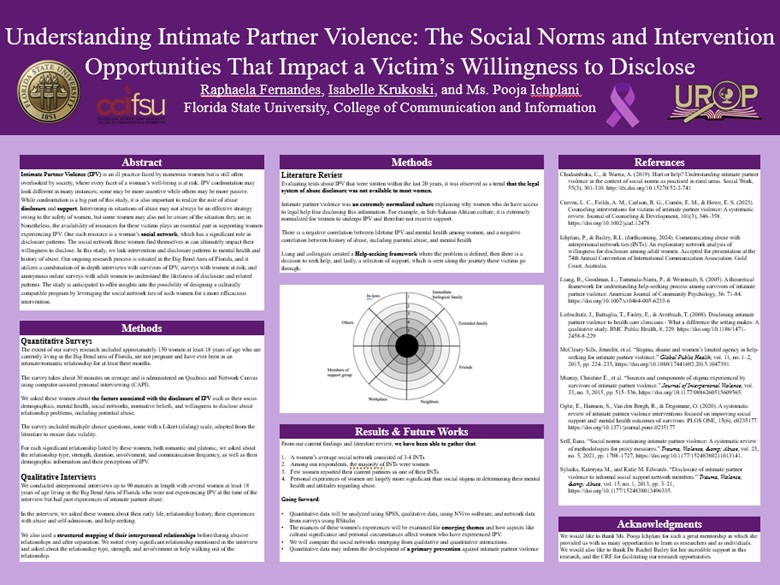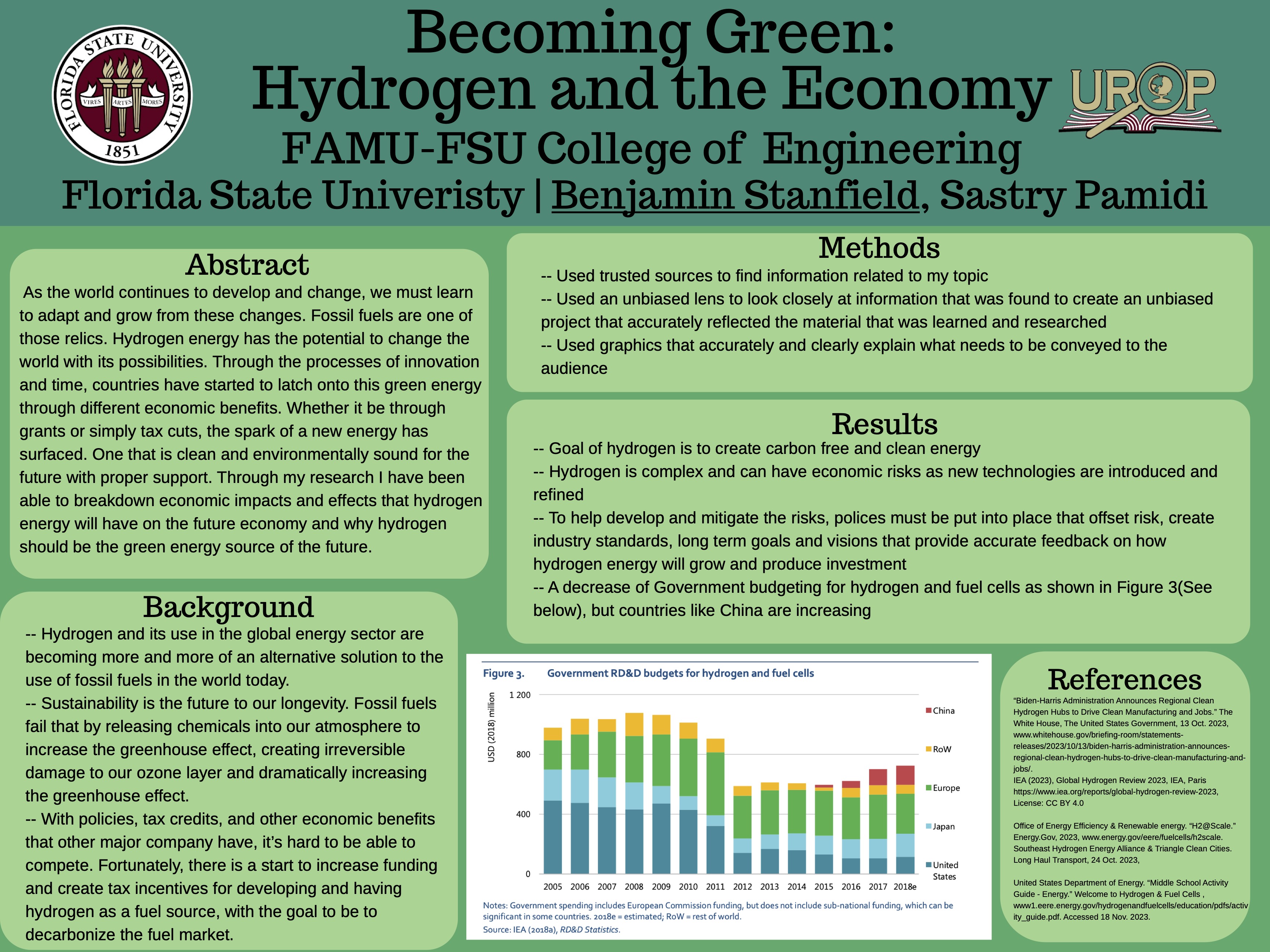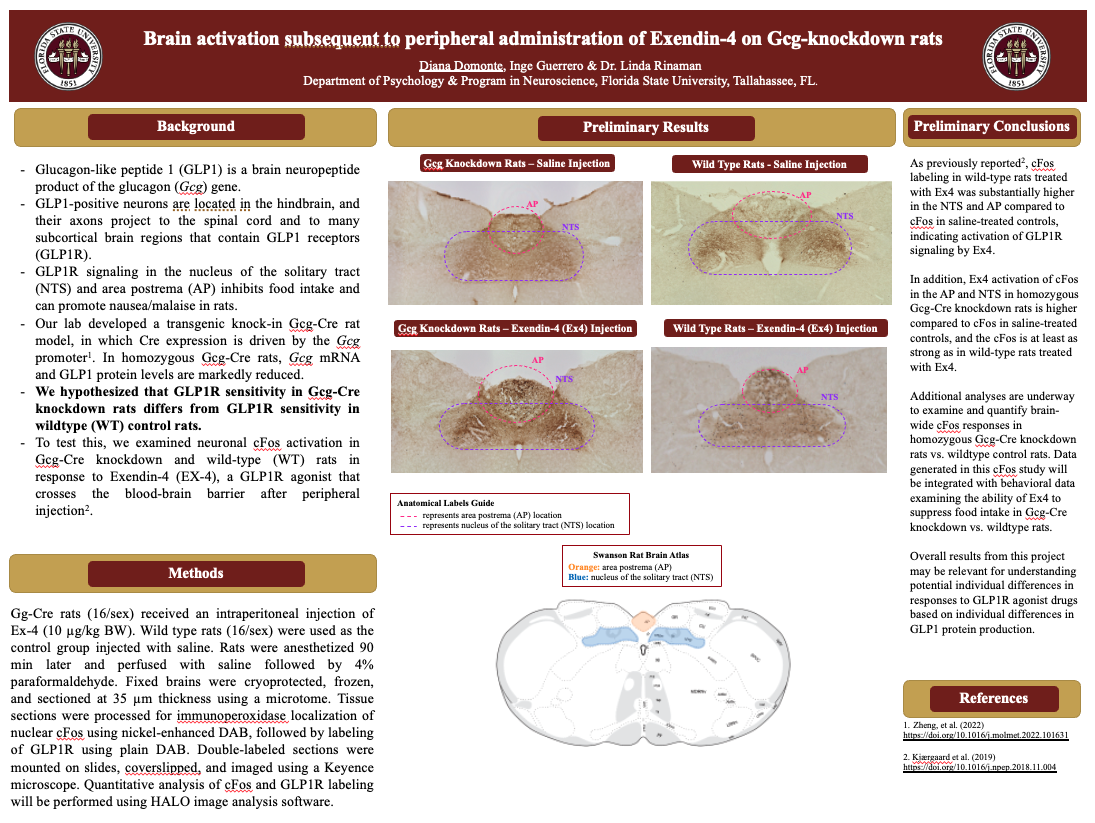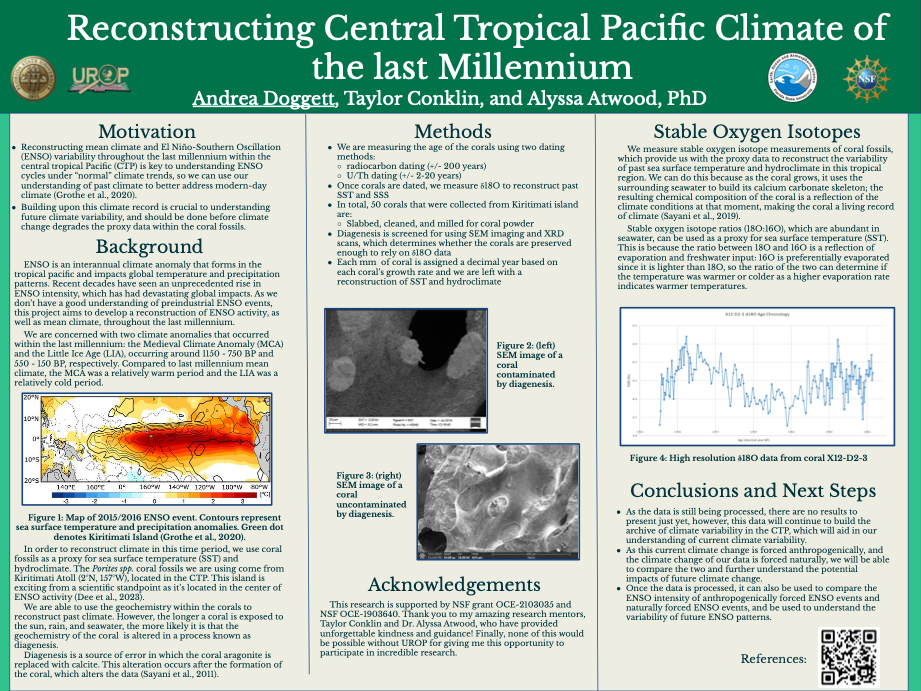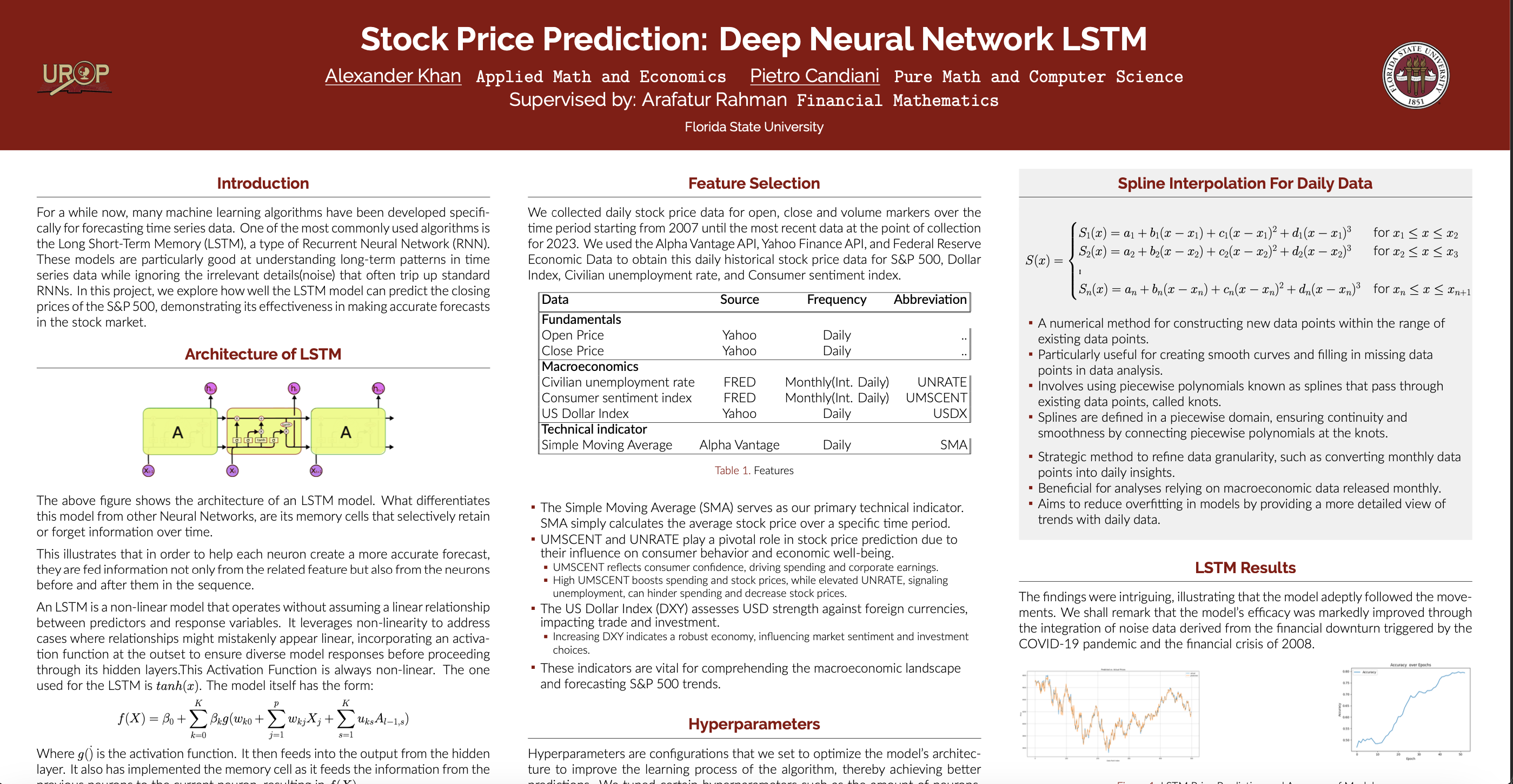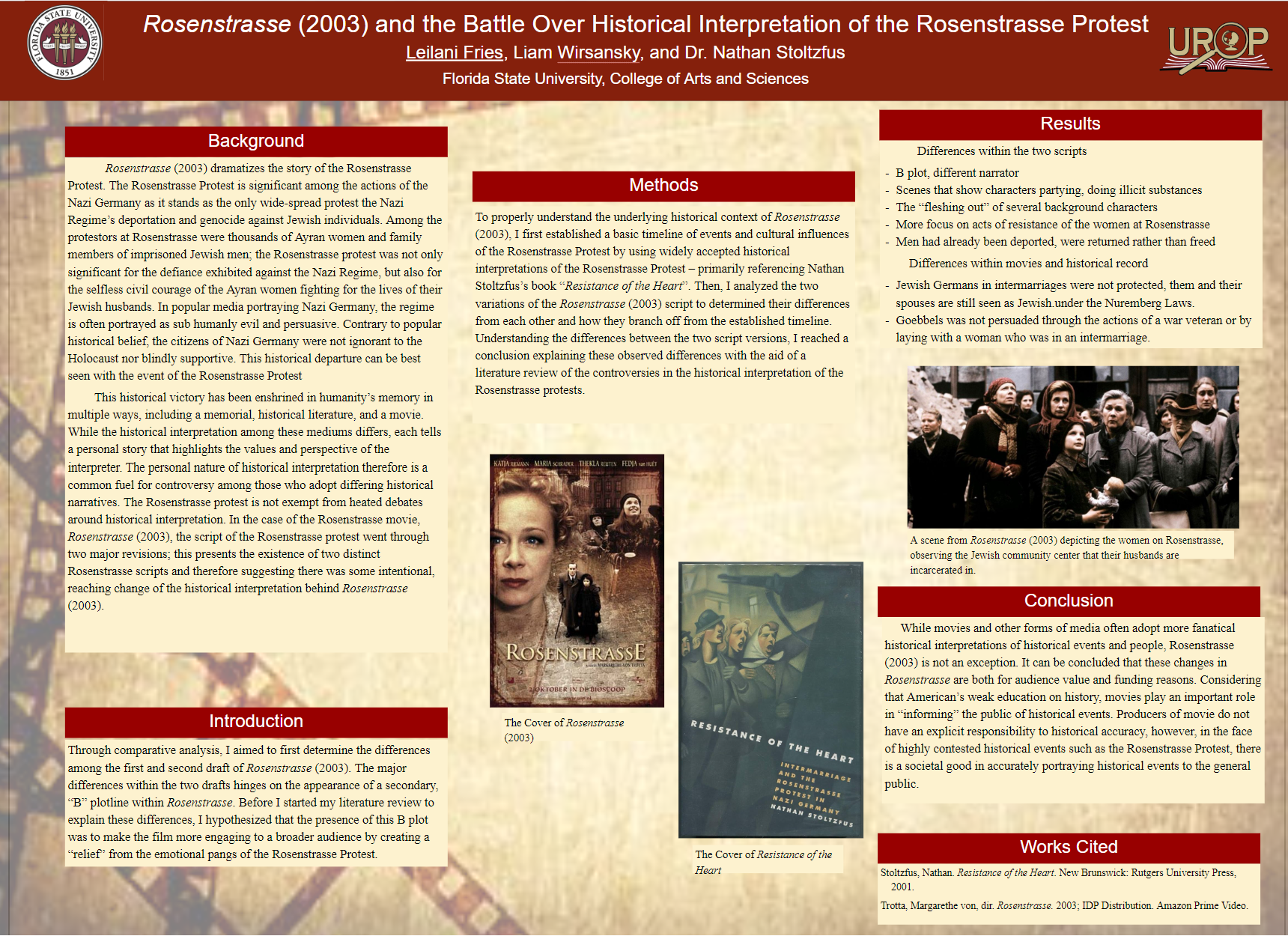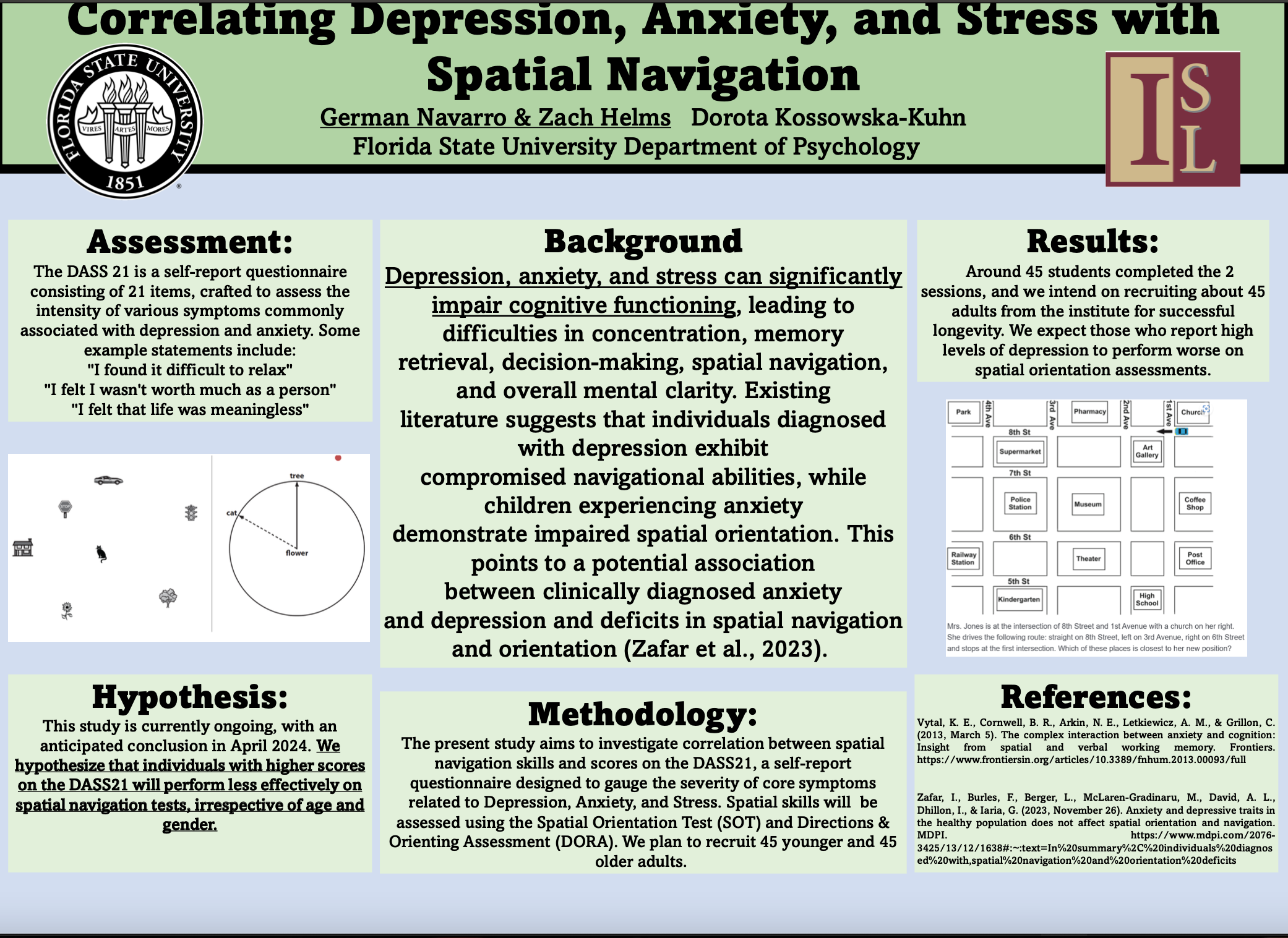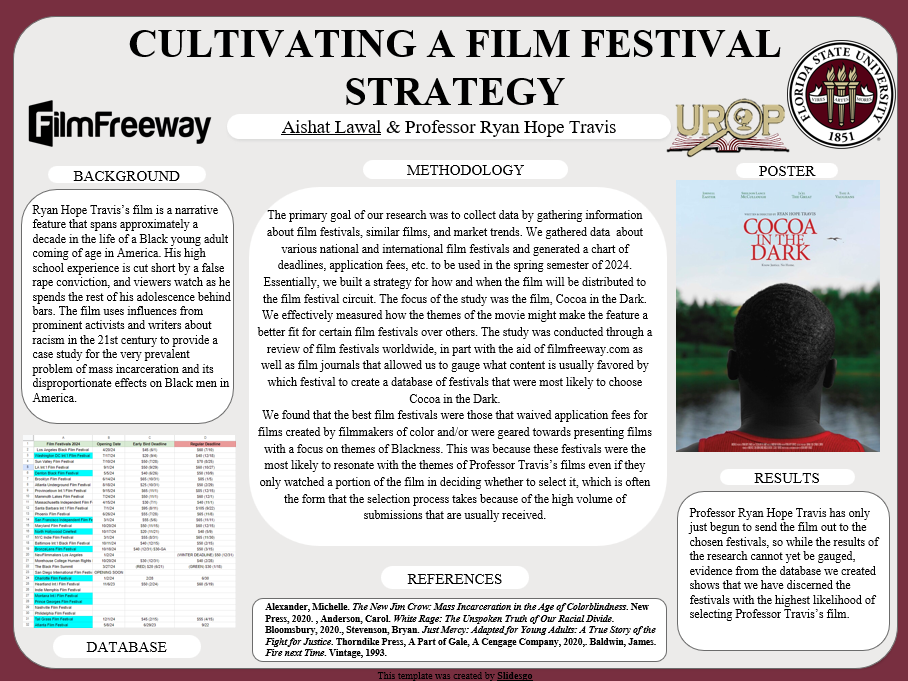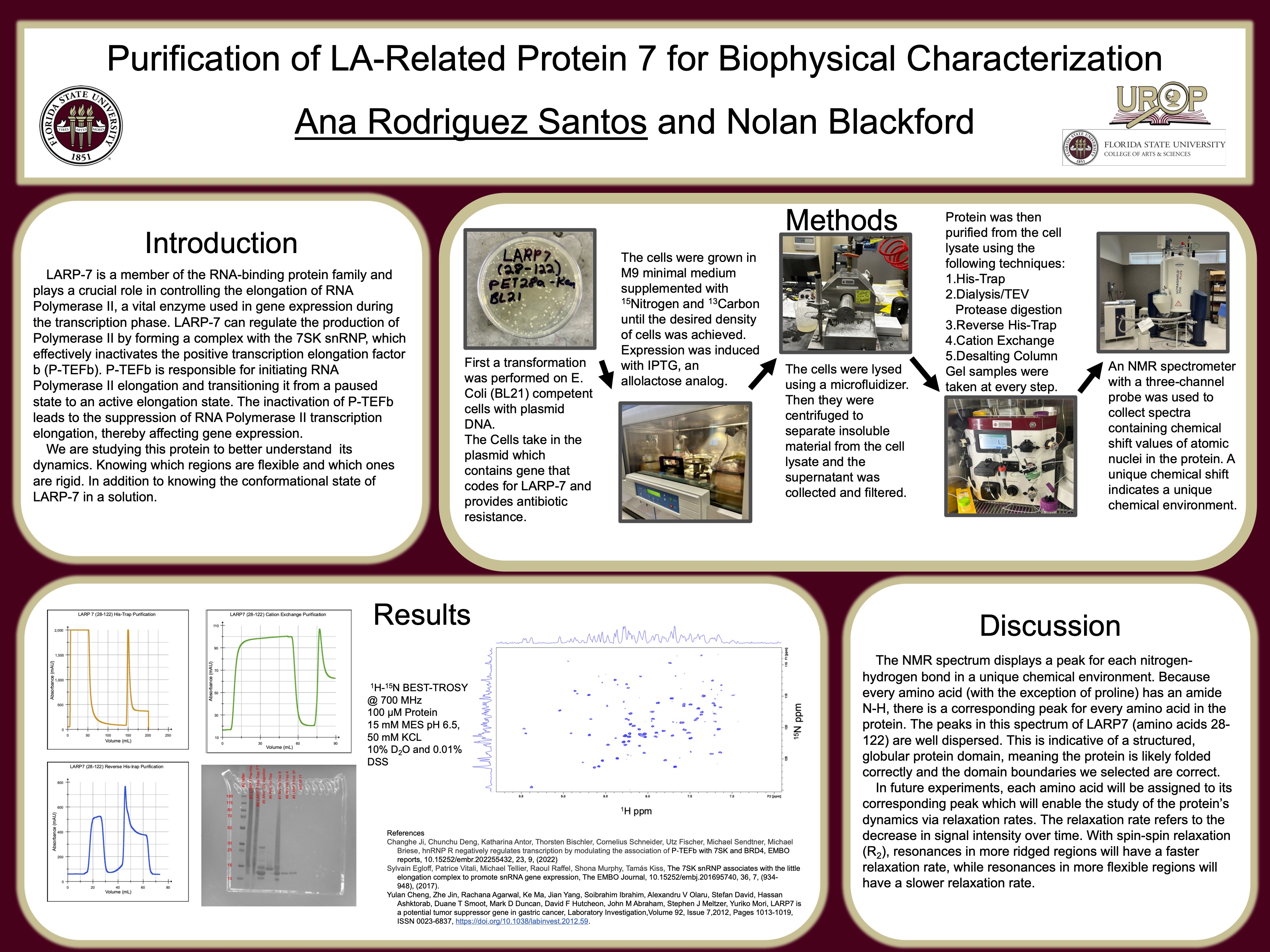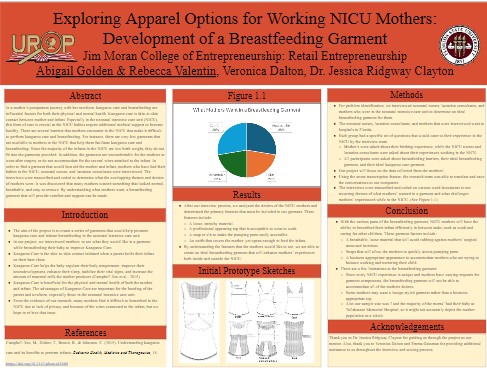Research Symposium
24th annual Undergraduate Research Symposium, April 3, 2024
Laila Martinez Poster Session 5: 4:00 pm - 5:00 pm/215

BIO
My name is Laila Martinez and I’m a freshman majoring in Interdisciplinary Medical Sciences. I’m originally from Fort Myers, FL. Besides being involved in UROP, I am currently a volunteer at Tallahassee Memorial Hospital in the Surgical Care Unit. I would love to continue participating in research throughout my undergraduate career. After graduating, I plan on going to medical school and becoming a physician.
Examining the Association Between Educational Attainment and Depressive Symptomology Across Racial/Ethnic Groups
Authors: Laila Martinez, Tyra DarkStudent Major: IMS: Clinical Professions
Mentor: Tyra Dark
Mentor's Department: Behavioral Sciences and Social Medicine Mentor's College: College of Medicine Co-Presenters:
Abstract
There are many external factors that may impact health. The purpose of this research is to examine how educational status and race/ethnicity are associated with depressive symptomatology. This study uses data from the National Health and Nutrition Examination Study (NHANES) to further expand on previous research to include more recent data. Study finding show there is an association between race and education with depressive symptomatology. This relationship likely stems from a multitude of factors, including a lack of resources and accessibility. This research is important to better understand how we can improve healthcare for all and provide insight into how we can create a better healthcare system for all patients.
Keywords: Medicine, Public-Health, Awareness
24th annual Undergraduate Research Symposium, April 3, 2024
Olivia Costes Poster Session 5: 4:00 pm - 5:00 pm/366
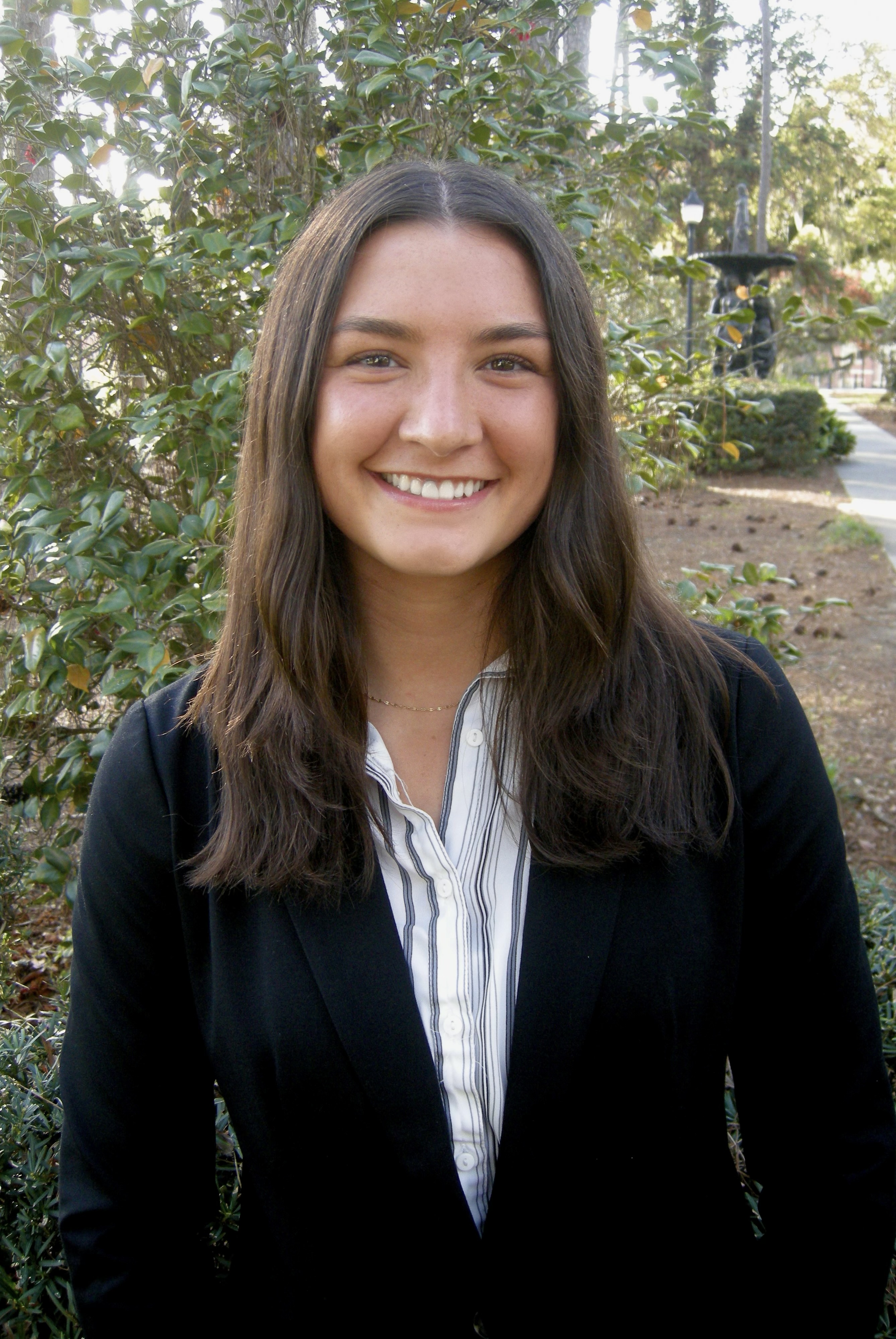
BIO
Hello! My name is Olivia Costes, a current second year student from Lexington, Kentucky. I am currently studying economics and mathematics in order to pursue a career in economic/financial research. I have always been interested in mathematics and its applications to the real world, so research is something I am very passionate about. Outside of academics I enjoy spending time with my dog, Moo, going on runs, and exploring the outdoors.
Learning From Personal and Impersonal Political Discussion
Authors: Olivia Costes, Marli DunietzStudent Major: Economics and Applied Mathematics
Mentor: Marli Dunietz
Mentor's Department: Political Science Mentor's College: College of Social Sciences and Public Policy Co-Presenters: Maegan Smarkusky
Abstract
The purpose of this research project is to better understand how social image plays a role in an individual's response to certain political issues. This research will fill a gap in second-order thinking research pertaining to political interaction and policy review. The overall study involves an individual's response to a relevant policy followed by a peer’s review of the response where the listener can decide to reward the respondent for their response. The most recent portion of the project involves reviewing responses and annotating them based on different interpersonal and political factors. The results are currently not conclusive, but they will be very useful to determine how to best structure political discussion in the future to minimize inaccuracies in public opinion due to second-order thinking.
Keywords: Political Discussion, Behavioral Economics, Political Science
24th annual Undergraduate Research Symposium, April 3, 2024
Samuel Willert Poster Session 5: 4:00-5:00 PM/279
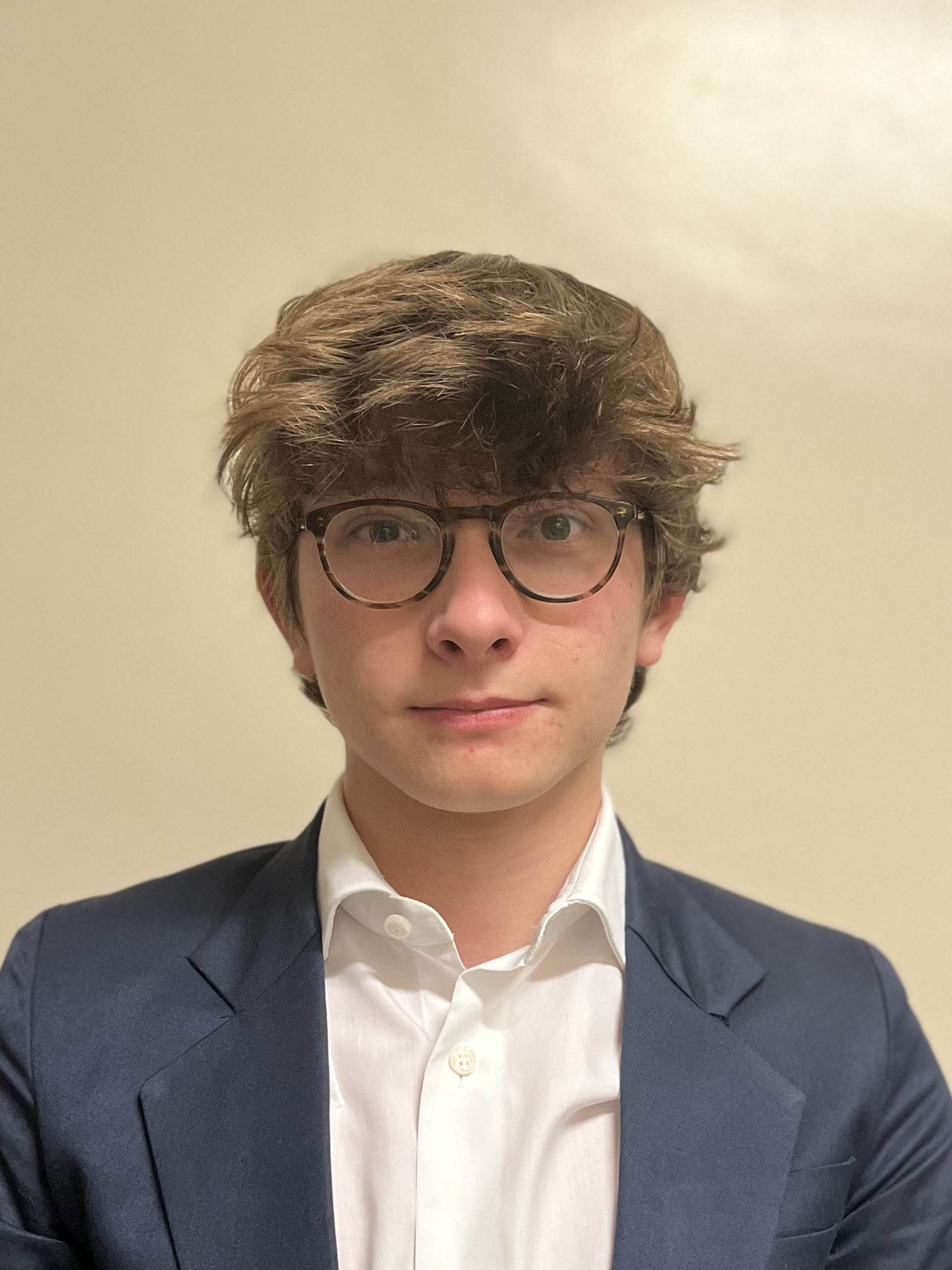
BIO
I am studying to attend medical school and eventually practice anesthesiology ideally. I have lived in Florida my whole life, and growing up in Pensacola, I always shared my mother's love for helping people. As a pediatrician's son, I was frequently exposed to hospital life, and knew how important the care my mom provided was. I knew I wanted to do research in the area of health, a project that could give me an entry look into the field, and inspire me to do further research in these areas. I definitely desire to do more in the area of artificial intelligence, as I believe with the right push, machine learning could be a profound factor in the medical industry, helping to save and better even more lives in the years to come.
Determining Produce Freshness Using Smartphone Imaging and Machine Learning
Authors: Samuel Willert, Luyao MaStudent Major: Biomedical Engineering
Mentor: Luyao Ma
Mentor's Department: Health, Nutrition, and Food Sciences Mentor's College: Florida State University Co-Presenters:
Abstract
In the United States, more than $408 billion worth of food is wasted each year, including 50% of produce such as fruits and vegetables. This food waste, especially in restaurant and commercial kitchens, is partially due to a general lack of methods for determining the freshness and remaining shelf-life of produce. This project aims to develop a consumer-friendly method that allows individuals to assess the freshness of produce. This will empower users to plan their fruit intake effectively and minimize food waste. Avocados were selected as the representative produce model due to their popularity. The avocados exhibit a noticeable color change, loss of firmness, and a shift in taste as they ripen, making them an ideal choice for this study. Avocados were stored at room temperature for up to 8 days to mimic the common storage condition. The freshness of avocados was assessed daily using a smartphone to capture images of the surfaces of the avocados. These images were then fed into and processed by an AI, machine-learning model to classify 5 freshness levels, based on color, lightness/darkness of the skin, and even texture. The results are then validated by comparing them to the standard methods, including colorimeter and texture analyzer. The colorimeter and texture analyzer provide information on the physical aspects of the fruit. This study provides a potential non-destructive, rapid, and easy-to-use method for consumers to reduce their home food waste.
Keywords: Produce, Artificial Intelligence, Freshness, Shelf life, Machine Learning
24th annual Undergraduate Research Symposium, April 3, 2024
Bridget Gorder Poster Session 2: 10:45 am - 11:45 am/194

BIO
Bridget Gorder, originally from Denver, Colorado, is a fourth-year Choral Music Education major at the Florida State University College of Music. Alongside honors research, Bridget is an active musician in the Tallahassee community and a highly involved student on campus. This summer, she will be completing an arts administration internship with the Sinfonia Gulf Coast prior to the final semester of her undergraduate career, where she will student teach chorus at Niceville High School in the Florida Panhandle. Additionally, she will be presenting her research at the MUSE Journal’s 5th annual conference, “Music in Dialogue”, hosted by the University of California, Los Angeles, Herb School of Music, in May. Her research will also be published in the conference edition of their Spring 2024 journal. Following her undergraduate degree, Bridget aspires to pursue a master’s degree in arts administration and build a career in not-for-profit music education, hoping to contribute to the movement of equitable access to music education for all.
Teaching Deaf and Hard-of-Hearing Students: A Guide for Secondary Choral Music Educators
Authors: Bridget Gorder, Dr. Steven KellyStudent Major: Choral Music Education (BME)
Mentor: Dr. Steven Kelly
Mentor's Department: Music Education Mentor's College: College of Music Co-Presenters:
Abstract
This thesis is focused on the inclusion of students with hearing impairments in the secondary choral music education. The study was conducted through a meta-analysis of existing literature, participant interviews with current music educators, music therapists, hard-of-hearing musicians, educational interpreters, and choral composers, an in-depth review of the interview transcriptions to serve as qualitative data, and a survey sent to current choral music education undergraduate students to check the interview data’s reliability. The results revealed over a dozen various methodologies that can be applied to hearing impaired students’ learning to facilitate their success, as well as indicated that music educators are generally unprepared to teach students with hearing impairments due to pedagogical deficiencies in university-level pre-service curriculum; additionally, the results implied that the inclusion of this population in the choral music classroom is attainable and that students with hearing impairments share a desire to pursue musical experiences. Ultimately, the study determined that music educators already have most of the tools they need in order to effectively teach these students, and by having a willingness to adapt, the largest change that is necessary is one of perspective.
Keywords: music, hard-of-hearing, deaf, choral, education
24th annual Undergraduate Research Symposium, April 3, 2024
Matthew Cabrera Poster Session 3: 1:30 pm - 2:30 pm /429
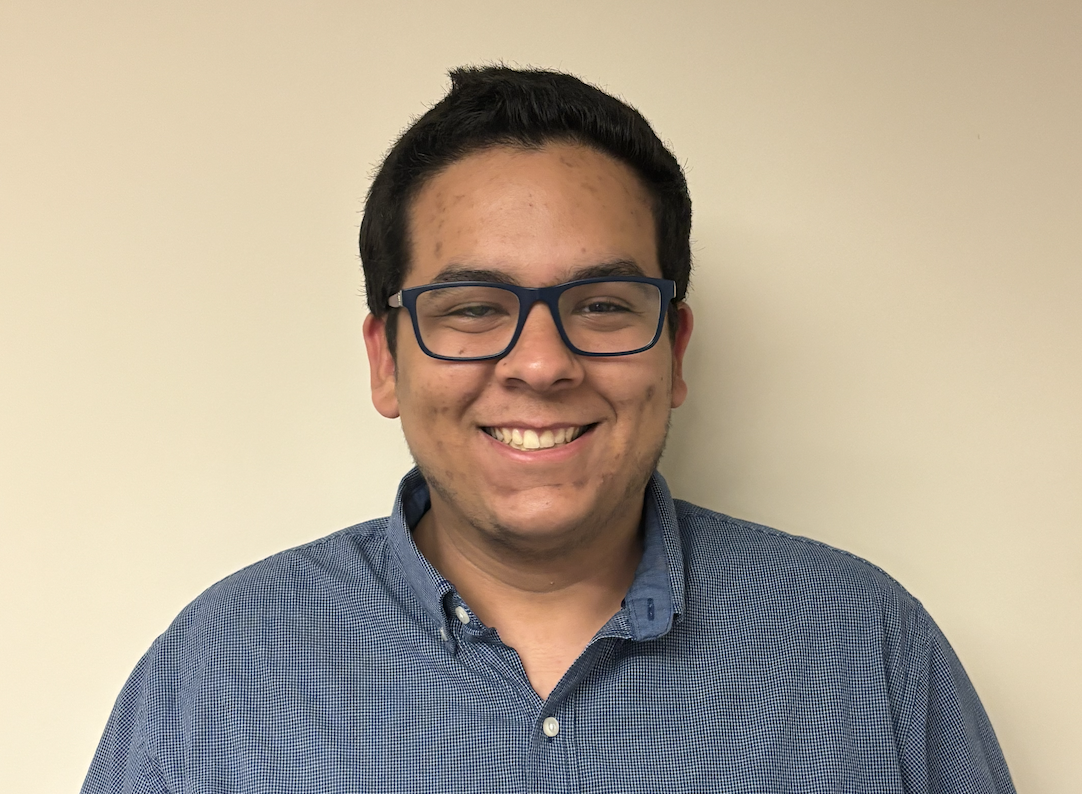
BIO
Hello! I am a first-year student at Florida State University studying Mechanical Engineering with the intention of attending graduate school for a Master's Degree in Aerospace Engineering. During my undergraduate career, I hope to complete two minors in Physics and Astrophysics in the Fall of 2024 and potentially obtaining a double major in an undetermined subject. I was born in Hialeah, FL but my parents moved to Ocala, FL when I was two years old, so I consider Ocala my home. I am an only child and the first generation in the United States, my parents were lucky enough to win the visa lottery and immigrated to the United States in 1998 from Cuba (Yes, I speak Spanish). During high school, I was fortunate enough to be a part of the International Baccalaureate (IB) program. Thanks to that IB background, I am fascinated with the multitude of research opportunities available at FSU including the Undergraduate Research Opportunites Program (UROP). Participating in UROP has allowed me to build the necessary foundations to continue my research throughout my undergraduate years, which to me, is essential for the diversification and identity of what I wish to do with my undergraduate career.
Hydrogen as a Sustainable Fuel for Aviation
Authors: Matthew Cabrera, Dr. Sastry PamidiStudent Major: Mechanical Engineering
Mentor: Dr. Sastry Pamidi
Mentor's Department: Electrical and Computer Engineering Mentor's College: FAMU-FSU College of Engineering Co-Presenters:
Abstract
Electric aircraft are the next step in electrification of transportation in the fight against climate change. The aviation industry produced 2% of the world’s carbon emissions. With the implementation of hydrogen fuel cells, both private and commercial sectors of the aviation industry can be transformed into low-carbon or zero-carbon sectors. In this literature review, hydrogen has been explored and evaluated as an alternative fuel for the next generation of the commercial aviation transportation industry. Hydrogen has already proven itself to be useful, NASA has been using it for years to fuel their Space Shuttle missions and Toyota was one of the first manufactures to develop and make commercially available, a hydrogen-powered vehicle. The use of hydrogen fuel cells in commercial aircraft provides many benefits but not without some challenges that need to be addressed. This research analyzed the benefits of hydrogen fuel cells and its implementation into the commercial aviation industry. Hydrogen is an answer to the climate crisis that faces us, but that does not mean it is perfect. However, companies like Boeing, Rolls Royce, and Airbus, and researchers from across the country are addressing the issues that hydrogen faces. That is the purpose of this study: evaluate the extent hydrogen technologies can be used for sustainable aviation to reverse the climate crisis.
Keywords: hydrogen, innovation, aviation, commercial, transportation
24th annual Undergraduate Research Symposium, April 3, 2024
Hailey Thompson Poster Session 3: 1:30 pm - 2:30 pm/402
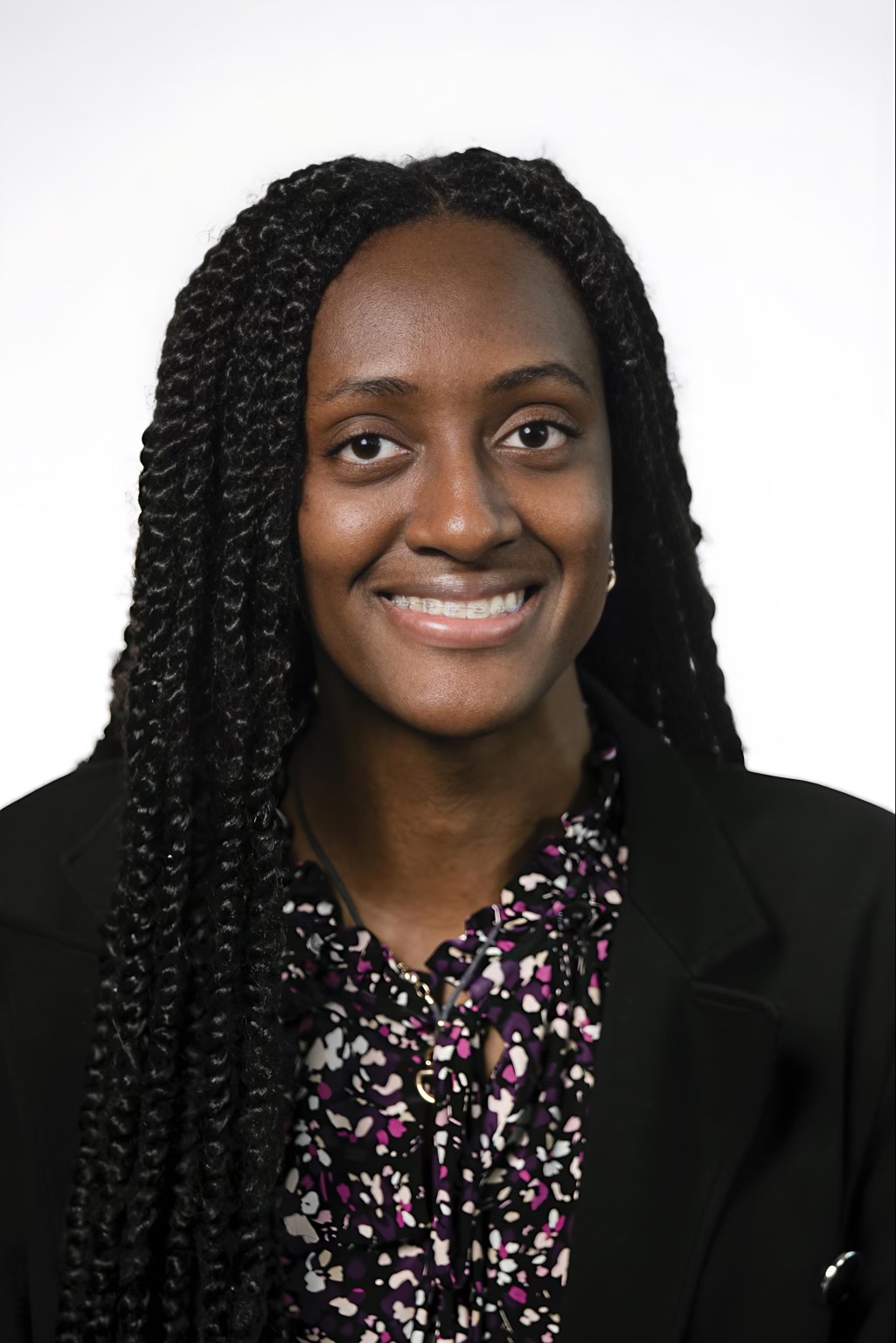
BIO
Hailey Thompson, a third-year international student from Ocho Rios, Jamaica, enjoys coding, reading, and volunteering. She is deeply passionate about her research interests in artificial intelligence, data science, and health informatics. Looking ahead, Hailey aspires to pursue graduate studies in data science, hoping to delve deeper into data analysis and machine learning to address societal challenges. She plans to continue her research endeavors in the eHealth Lab alongside her mentors, Dr. He and Dr. Bhasuran. With her passion and determination, Hailey is excited to make a meaningful impact in data science and beyond. Alongside her studies, she actively engages in community service. She is active in organizations such as the Alliance for Black Women, the Jamaican-American Student Association, Women in Computer Science, and the Caribbean Student Association.
Evaluating Large Language Models for Accurate Lab Test Question Interpretation
Authors: Hailey Thompson, Zhe HeStudent Major: Computer Science
Mentor: Zhe He
Mentor's Department: School of Information Mentor's College: College of Communication & Information Co-Presenters: Caroline Bennett & Angelique Deville
Abstract
The LabGenie project aims to address the challenge of patients, especially the elderly, in understanding medical lab test results and acting upon them. Even though generative AI models such as ChatGPT can answer questions, patients may not know what questions to ask, and they may also generate answers with inaccurate information or hallucinations. In the eHealth Lab, we are developing informatics strategies to augment large language models (LLM) by 1) identifying credible health sources for lab test result interpretation, and 2) curating these sources to computable format. As such, they can be used for question prompt enrichment with human input and retrieval-augmented generation (RAG). The ultimate goal is to integrate the RAG-based LLMs with a user-friendly interface for patients. LabGenie seeks to allow patients with low health literacy to ask contextualized questions and make informed health decisions with their providers confidently. The research involves literature reviews on LLM capabilities in clinical settings, converting lab result interpretation into a table format, and evaluate strengths and weaknesses of different LLMs in answering lab result questions. These procedures aim to provide meaningful results to train LLMs and contribute to the creation of LabGenie.
Keywords: AI, Health Literacy, Lab Result Interpretation
24th annual Undergraduate Research Symposium, April 3, 2024
Reagan Stern Poster Session 5: 4:00 pm - 5:00 pm/360
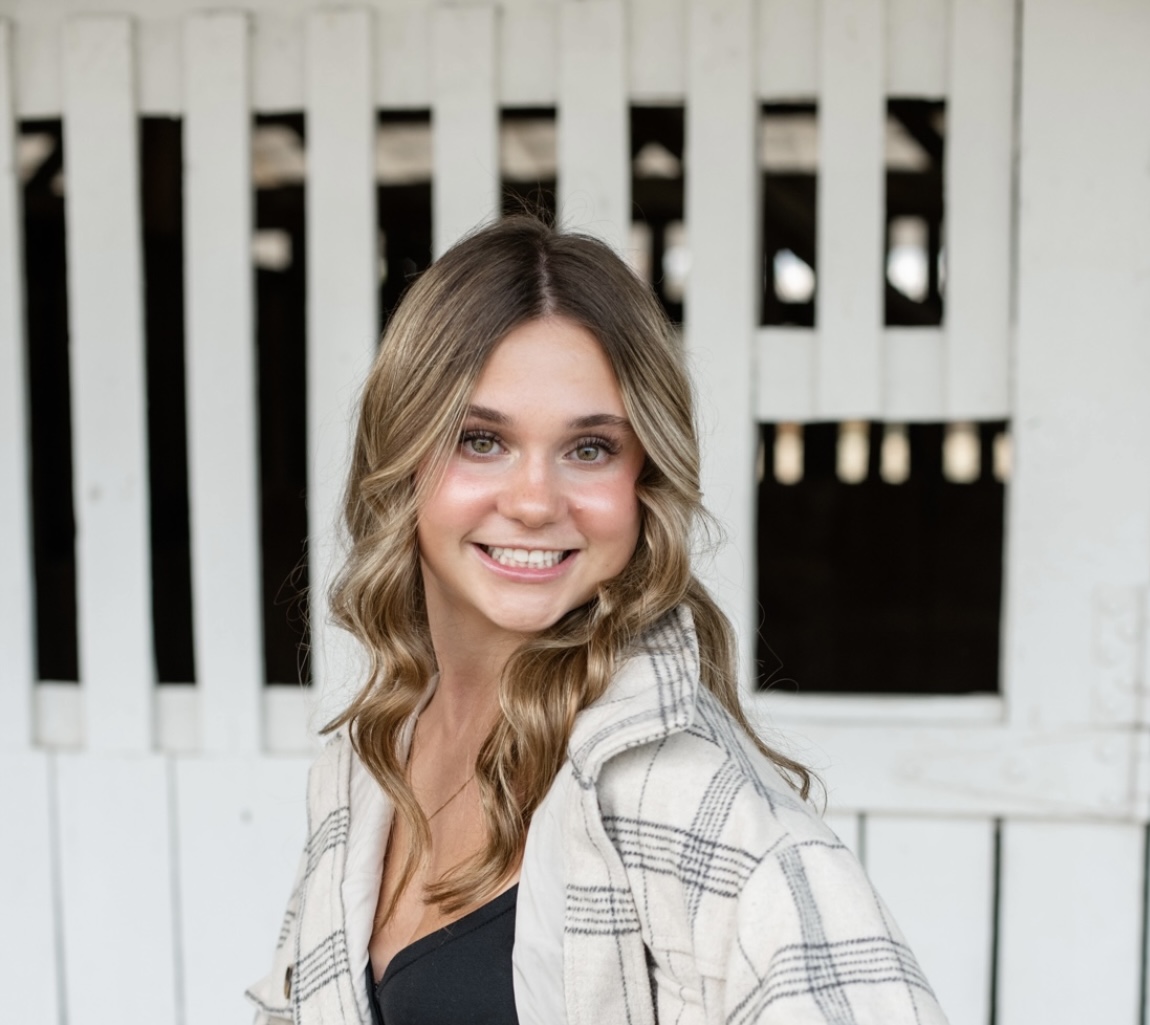
BIO
My name is Reagan Stern, and I am originally from San Diego, California, but currently live just south of Nashville, Tennessee. I am currently a freshman majoring in cell and molecular neuroscience and apart of the honors program at Florida State. Currently, I am involved in my sorority, Gamma Phi Beta, and in FSU Panhellenic through CORE. I am also involved in Nu Rho Psi (Neuroscience Honors Society) and NUSA (Neuroscience e Undergraduate Student Association). I aspire to go to both medical school and graduate school through an MD/PhD program to become either a pediatric oncologist or a neonatologist, while still conducting biomedical research.
Exploring Arterial Dysfunction in C57BL/6J Mice through Histological Examination
Authors: Reagan Stern, Daniel MachinStudent Major: Cell and molecular neuroscience
Mentor: Daniel Machin
Mentor's Department: Health, Nutrition, and Food Sciences Mentor's College: College of Education, Health, and Human Sciences Co-Presenters: Mattia Reformato-Santoro
Abstract
Age- and lifestyle-related changes in the structural and functional properties of arteries contribute to impaired vascular function, elevated blood pressure, and a heightened risk of cardiovascular disease. Despite the well-established benefits of regular exercise and a healthy diet in preventing obesity and promoting heart health, the prevalence of a high salt, high-fat diet, and inadequate physical exercise in the typical American lifestyle contributes to cardiovascular disease. This research focuses on understanding how interventions, specifically exercise and dietary modifications, that have an effect on the restoration of vascular function. For this research, we will be using the C57BL/6J mice, which is an inbred strain that was the first to have their genome completely sequenced. These mice are particularly useful for studying cardiovascular diseases related to aging because they have low bone density, are capable of developing diet-induced obesity, and type 2 diabetes. After dietary exposure, mice were dissected, and their aortas were preserved, sliced, stained, and microscopically analyzed. The histology analysis detailed examination of the differences between the normal chow and western diets. The findings from this study contribute valuable insights into the intricate relationship between diet, exercise, and cardiovascular health. By utilizing the C57/BL/6J mouse model, this research enhances our understanding and ultimately paves the way for targeted interventions and preventive strategies in cardiovascular health.
Keywords: Arterial Dysfunction, Elastin, Trichrome, Mice
24th annual Undergraduate Research Symposium, April 3, 2024
Jillian Kessler Poster Session 3: 1:30 pm - 2:30 pm /21
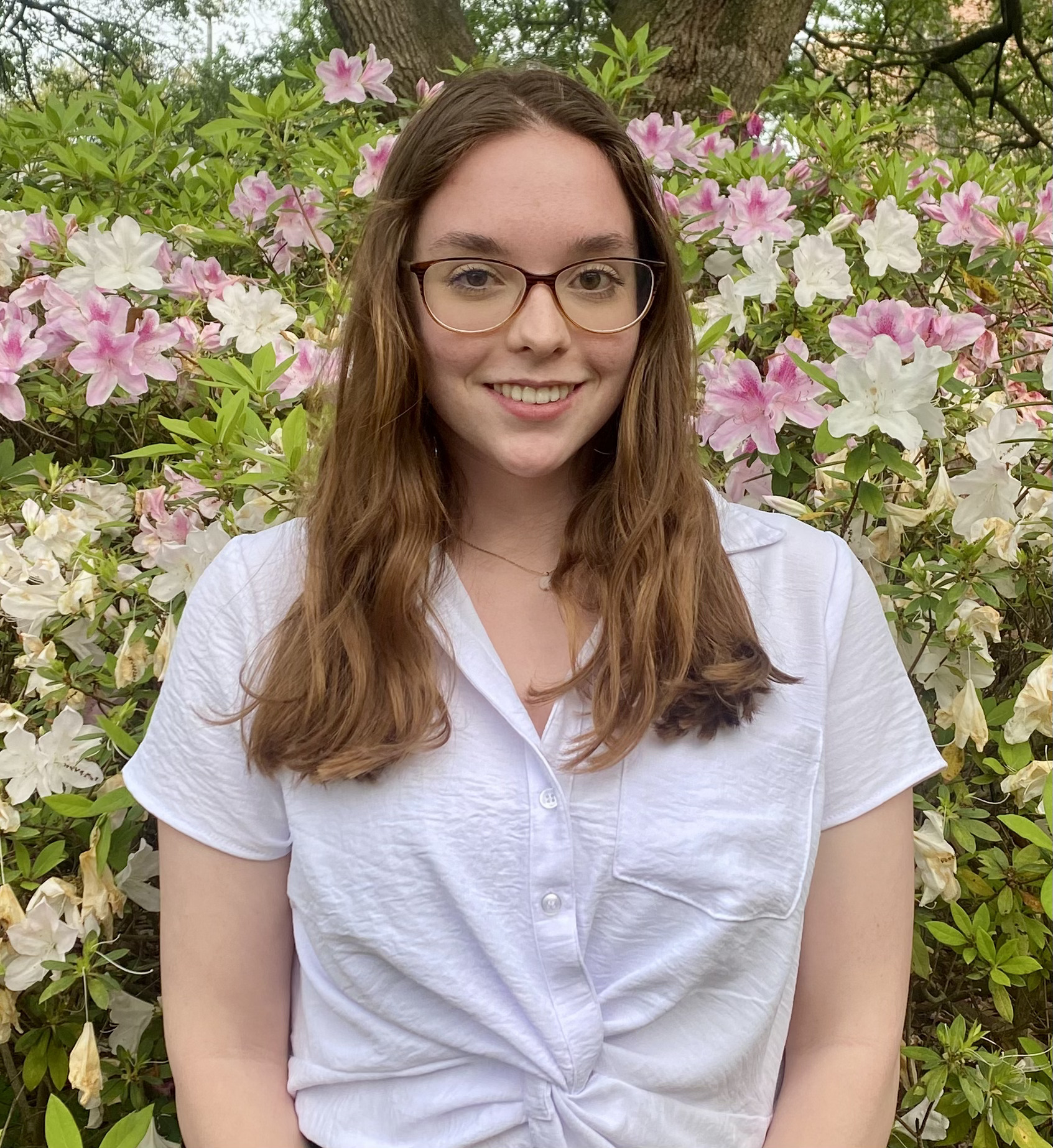
BIO
Jillian Kessler is pursuing her bachelor degree in communication science and disorders at Florida State University. She is from Boca Raton, Florida and is hoping to get into a master's program to continue her education as a speech-language pathologist. Her research interests include reading strategies for children, cognitive communication disorders, and speech sound disorders.
Developing an Adaptive Professional Development Model for School Professionals' Implementation of Shared Reading Activities
Authors: Jillian Kessler, Dr. Kelly FarquharsonStudent Major: Communication Science Disorders
Mentor: Dr. Kelly Farquharson
Mentor's Department: School of Communication Science and Disorders Mentor's College: College of Communication and Information Co-Presenters: Maggie Acquavivia
Abstract
This study was motivated primarily by past obstacles faced when training educators and speech-language pathologists (SLPs) to implement dialogic reading strategies with school children. Dialogic reading is a systematic form of interactive shared book reading with positive effects on the development of children’s oral language skills and could have similar benefits with students with disabilities. This study, driven by the need to reevaluate the approach to training educators in this technique, also may yield crucial information on the effectiveness of different professional development (PD) training components for future use in schools.
This study seeks to create PD training modules to aid educators and SLPs with the implementation of dialogic reading skills for the purpose of improving children’s literacy. Participants will submit three self-recordings of shared reading sessions with young children ages 3-8 years, in order to establish a baseline. After they are coded and analyzed, the participants will receive a video training module instructing them on the implementation of the Prompt, Evaluate, Expand, Repeat (PEER) technique. Finally, they will re-record the sessions using tools learned in the PD module, which will be coded using a web-based video-coding program, Vosaic, and analyzed by Microsoft Excel to determine if further coaching is needed, in which case this will take place in the form of individualized Zoom sessions and they will begiven written and verbal feedback. This is an ongoing two-year trial and data collection is still underway. The expected date of completion is the end of summer 2025.
Keywords: children reading education SLP
24th annual Undergraduate Research Symposium, April 3, 2024
Isabelle Krukoski Poster Session 2: 10:45 am - 11:45 am/206
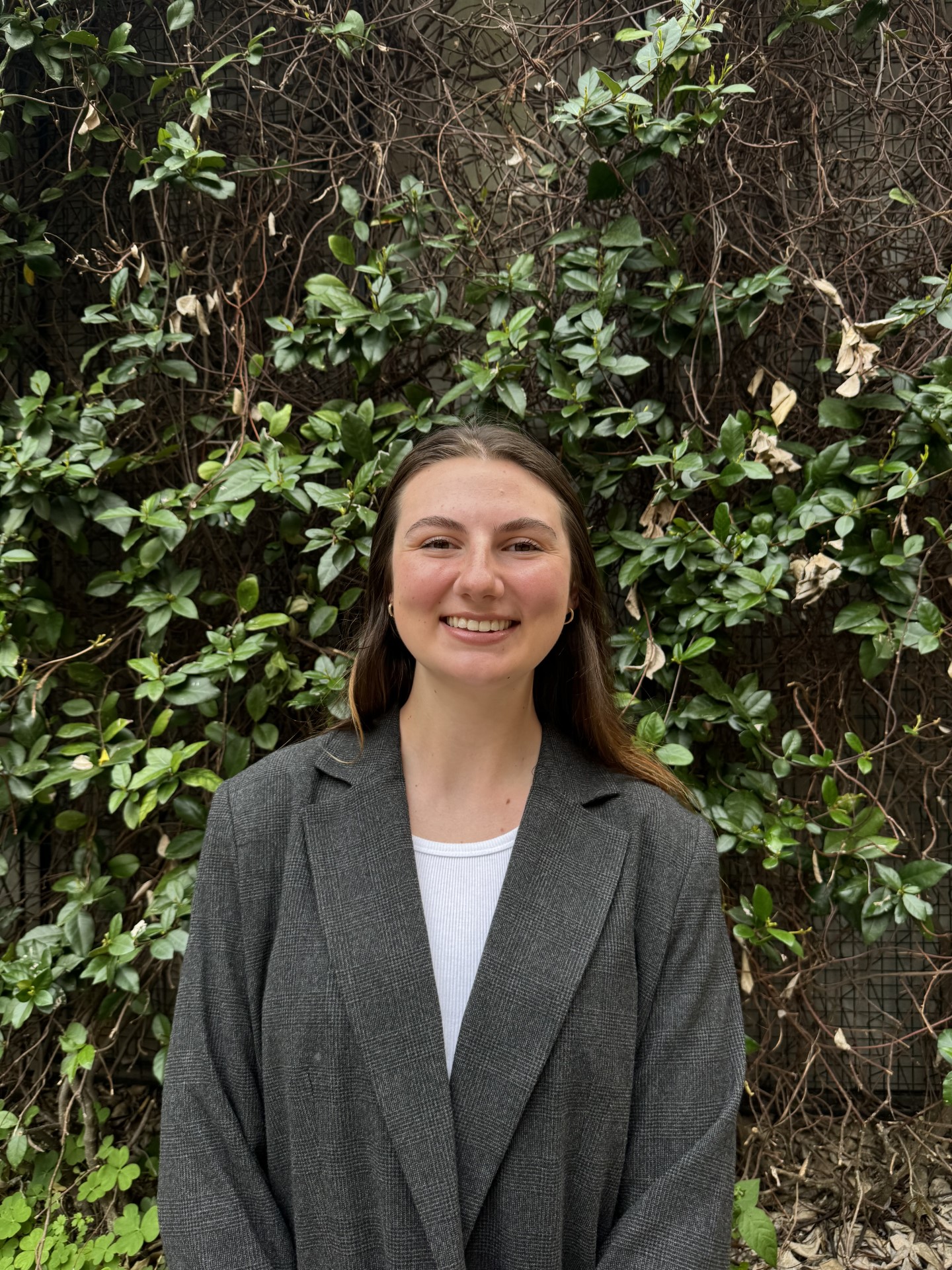
BIO
Hi! My name is Isablelle Krukoski, I am a sophomore from Clermont, FL, and I am double majoring in Editing Writing and Media & Media and Communication Studies at FSU. Currently, I am working under the wonderful PhD student, Pooja Ichplani, as a part of FSU's Undergraduate Research Opportunity Program (UROP) researching intimate partner violence and how social norms, available resources, and social networks impact a victim's willingness to disclose. Beyond research, I am a staff writer with Her Campus at FSU and have a strong passion for composing and collaborating on editorial work.
Understanding Intimate Partner Violence: The Social Norms and Intervention Opportunities That Impact a Victim's Willingness to Disclose
Authors: Isabelle Krukoski, Pooja IchplaniStudent Major: Editing, Writing, and Media / Media and Communications
Mentor: Pooja Ichplani
Mentor's Department: College of Communication and Information Mentor's College: College of Communication and Information Co-Presenters: Raphaela Fernandes
Abstract
Intimate Partner Violence (IPV) is an ill practice faced by numerous women but is still often overlooked by society, where every facet of a woman’s well-being is at risk. IPV confrontation may look different in many instances; some may be more assertive while others may be more passive. While confrontation is a big part of this study, it is also important to realize the role of abuse disclosure and support. Intervening in situations of abuse may not always be an effective strategy owing to the safety of women, but some women may also not be aware of the situation they are in. Nonetheless, the availability of resources for these victims plays an essential part in supporting women experiencing IPV. One such resource is a woman’s social network, which has a significant role in disclosure patterns. The social network these women find themselves in can ultimately impact their willingness to disclose. In this study, we link intervention and disclosure patterns to mental health and history of abuse. Our ongoing research process is situated in the Big Bend Area of Florida, and it utilizes a combination of in-depth interviews with survivors of IPV, surveys with women at risk, and anonymous online surveys with adult women to gather insights into the likeliness of disclosure and related patterns. The study is anticipated to offer insights into the possibility of designing a culturally compatible program by leveraging the social network ties of such women for a more efficacious intervention.
Keywords: Intimate Partner Violence
24th annual Undergraduate Research Symposium, April 3, 2024
Benjamin Stanfield Poster Session 1: 9:30 am - 10:30 am /397
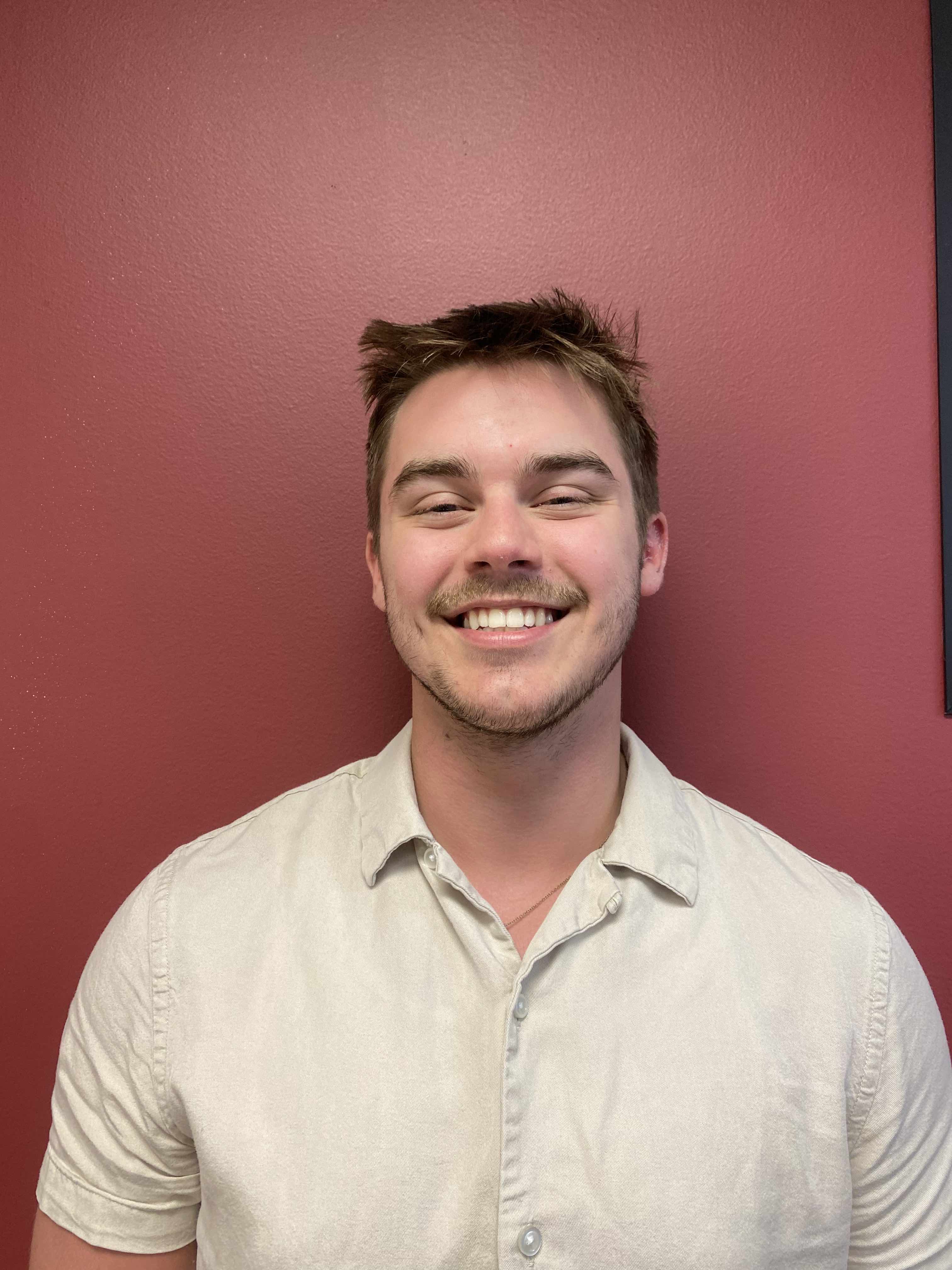
BIO
Originally from Cincinnati Ohio came to Florida State to study environmental science and to develop myself as a person and professionally. I have been able to learn from our many amazing professors in the EOAS department as I work towards my major and future plans of helping our natural world threw research and advocacy. Outside of the classroom you can find me on the courts and fields of our many FSU sports team as apart of our Cheer team, and occasionally enjoying the Florida weather in any way possible.
Becoming Green: Hydrogen and the Economy
Authors: Benjamin Stanfield, Sastry PamidiStudent Major: Environmental Science
Mentor: Sastry Pamidi
Mentor's Department: Professor of Electrical & Computer Engineering, Associate Director of Center for Advanced Power Systems (CAPS) Mentor's College: FAMU-FSU College of Engineering Co-Presenters:
Abstract
As the world continues to develop and change, we must learn to adapt and grow from these changes. Fossil fuels are one of those relics. Hydrogen energy has the potential to change the world with its possibilities. Through the processes of innovation and time, countries have started to latch onto this green energy through different economic benefits. Whether it be through grants or simply tax cuts, the spark of a new energy has surfaced. One that is clean and environmentally sound for the future with proper support. Through my research I have been able to breakdown economic impacts and effects that hydrogen energy will have on the future economy and why hydrogen should be the green energy source of the future.
Keywords: Hydrogen, Sustainability, Future, Fuel Cells
24th annual Undergraduate Research Symposium, April 3, 2024
Diana Domonte Poster Session 1: 9:30 am - 10:30 am /49
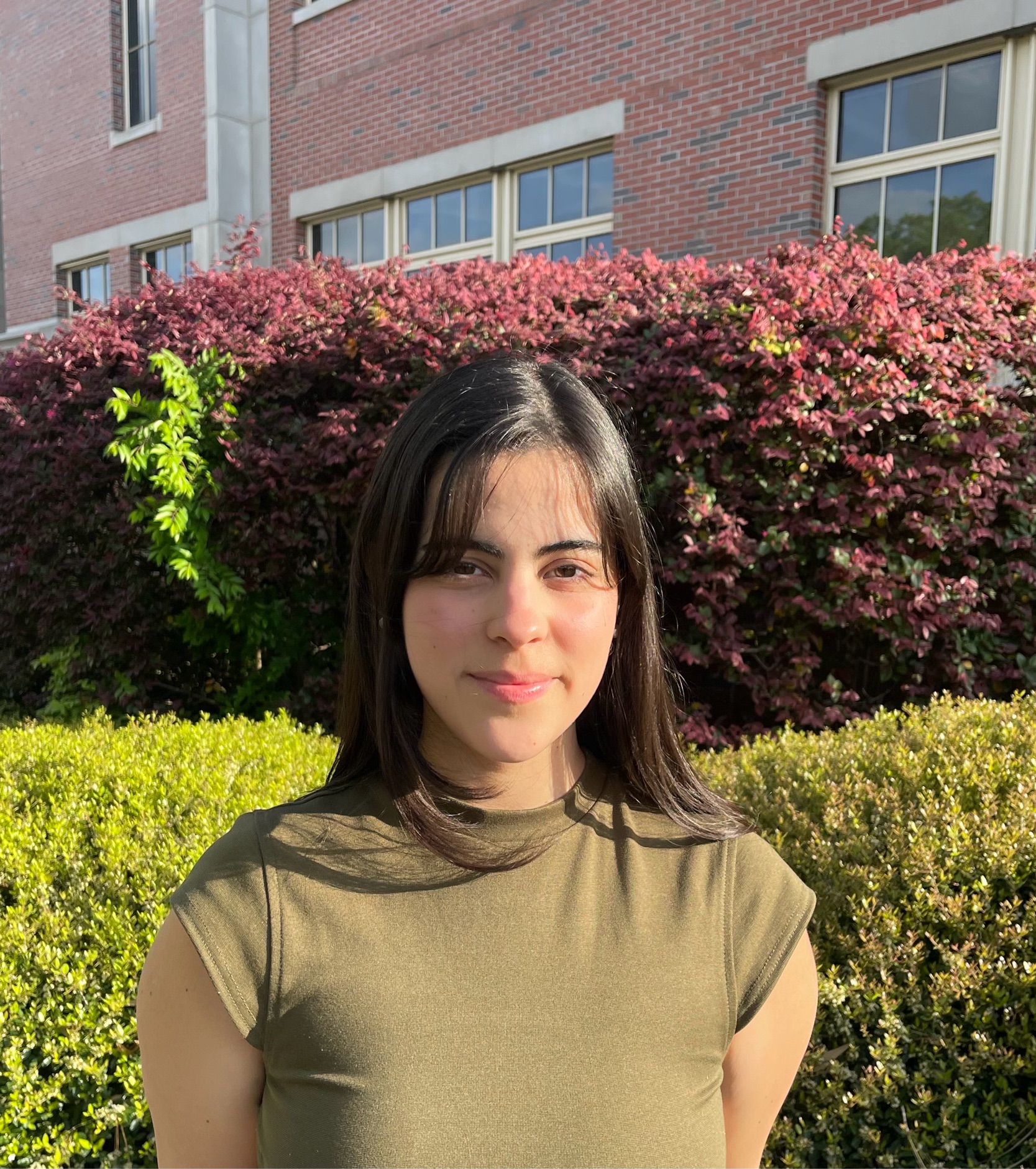
BIO
Hello! I'm Diana Domonte, a Venezuelan undergraduate student majoring in behavioral neuroscience with a minor in chemistry. My current interests include sleep disorders, the impact of stress on physiology and behavior, neurobiological mechanisms in relation to metabolic functions, and neurodegenerative diseases. Currently, I'm working as an undergraduate research assistant for Dr. Linda Rinaman. Beyond academics, I enjoy dancing and reading.
Brain activation subsequent to peripheral administration of Exendin-4 on Gcg-knockdown rats
Authors: Diana Domonte, Linda RinamanStudent Major: Behavioral Neuroscience
Mentor: Linda Rinaman
Mentor's Department: Psychology Mentor's College: Arts and Sciences Co-Presenters:
Abstract
Glucagon-like peptide 1 (GLP1) is a brain neuropeptide product of the glucagon (Gcg) gene. GLP1 binds to GLP1 receptors (GLP1R) located throughout the brain, and is critical for regulating autonomic functions, food intake, and other motivated behaviors. Our lab discovered that transgenic homozygous knock-in rats that express Cre driven by the Gcg promoter (Gcg-Cre rats) have markedly less Gcg mRNA and GLP1 protein, making them a useful GLP1 knockdown model. However, exendin-4 (Ex4), a GLP1R agonist that acts in the brain after peripheral injection, should still activate neurons that express GLP1R in these knockdown rats. The present study examines brain-wide cFos responses in Gcg-Cre knockdown rats and wild-type rats after peripheral injection of Ex4 to test the hypothesis that GLP1R sensitivity differs between genotypes. A total of 32 Gcg-Cre rats were injected i.p. with 10 µg/kg of Ex4 and then anesthetized and perfused 90 min later with saline followed by 4% paraformaldehyde. Fixed brains were then frozen and sectioned at 35 µm using a microtome, and subsequently double-immunolabeled using rabbit-anti-cFos and mouse-anti-GLP1R. Labeled tissue sections were mounted on slides, coverslipped, and imaged using a Keyence microscope. Analyzed regions will include brainstem, thalamic, hypothalamic, and forebrain regions that express GLP1R. However, results and conclusions from this study are still pending as we analyze imaged labeling data using HALO software for quantitative analysis. The results will be relevant to understanding potential individual differences in responses to GLP1R agonist drugs based on individual differences in GLP1 protein production.
Keywords: Glucagon-like peptide 1 (GLP1), cFos responses, food intake inhibition, GLP1R agonist drugs
24th annual Undergraduate Research Symposium, April 3, 2024
Andrea Doggett Poster Session 1: 9:30 am - 10:30 am /13
BIO
I am in my second year at Florida State University, majoring in Geology. My hometown is Fort Myers, Florida, where my passion for conserving the local ecosystem ignited my interest in environmental studies. This early fascination has shaped my academic journey and overall life perception. I joined Atwood lab as a participant in the Undergraduate Research Opportunity Program (UROP). Currently, I am aiding my mentor, Taylor Conklin, in her research examining the stable isotopes and geochemical tracers found in coral fossils to reconstruct valuable paleoclimate data.
When I have the time, I enjoy spending time in nature doing activities like hiking, kayaking, and other similar outdoor pursuits. I also love being with my friends and family and playing board games!
Reconstructing Central Tropical Pacific Climate of the last Millennium
Authors: Andrea Doggett, Taylor ConklinStudent Major: Geology
Mentor: Taylor Conklin
Mentor's Department: EOAS Mentor's College: Florida State University Co-Presenters:
Abstract
Reconstructing mean climate and El Niño-Southern Oscillation (ENSO) variability throughout the last millennium within the central tropical Pacific (CTP) is key to understanding how current anthropogenic forcing will affect climate trends in the future, both within this region and globally. Using Porites spp. coral fossils from Kiritimati Atoll (2°N, 157°W), we collected quantitative, high-resolution paleoclimate data for this previously understudied island in the CTP. Stable isotope and trace element composition measurements of these coral fossils provide us with the proxy data we need to reconstruct the variability of past sea surface temperature and hydroclimate in this tropical region. These reconstructions of the last millennium climate focus on El Niño/La Niña cycles during two specific climate anomalies: the Medieval Climate Anomaly (MCA) and the Little Ice Age (LIA), occurring around 1150 - 750 BP and 550 - 150 BP, respectively. The ratio of stable oxygen isotopes (δ18O:δ16O) is used as a proxy for temperature, as it reflects evaporation and freshwater input; since 16O is preferentially evaporated, and evaporation is increased with increased temperature, subtropical and tropical areas tend to have a greater abundance of 18O compared to 16O. However, there are many extraneous variables to control for with δ18O, so we also collect Sr/Ca and Sr-U ratios within the coral matrix to correct for these variables. Building upon this climate record is crucial to understanding future climate variability, and it needs to be done quickly before climate change degrades the proxy data within the coral fossils.
Keywords: Paleoclimate, Coral, ENSO, Climate Change
24th annual Undergraduate Research Symposium, April 3, 2024
Alexander Khan Poster Session 2: 10:45 am - 11:45 am/230
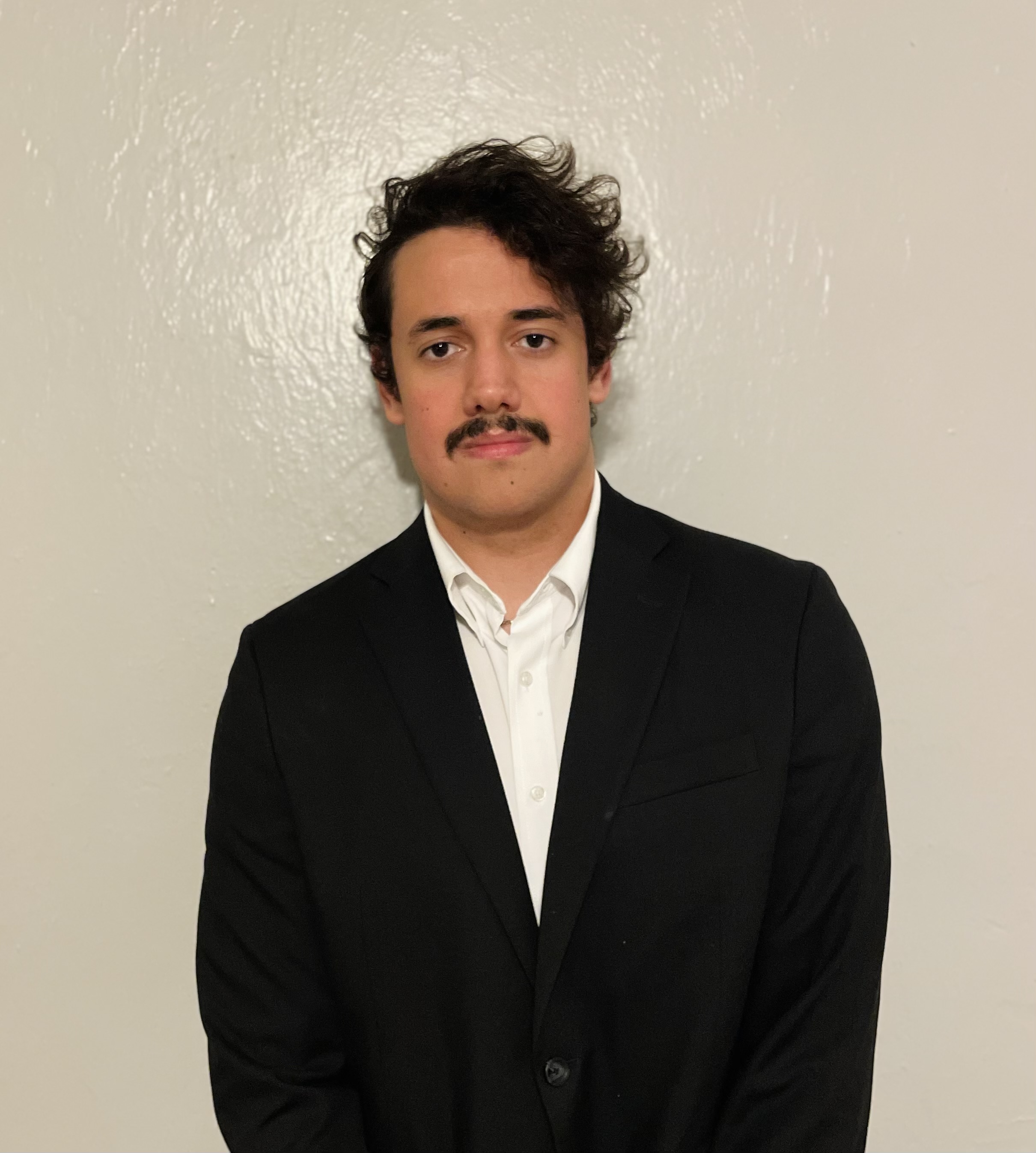
BIO
Applied mathematics post-baccalaureate student with prior education in economics at Florida State University. I am interested in machine learning, neural networks, deep learning, financial math, and statistics. My current academic journey involves synthesizing prior knowledge of economics with current interests in advanced computational fields.
Stock Price Prediction: Deep Neural Network LSTM
Authors: Alexander Khan, Arafatur RahmanStudent Major: Applied Mathematics, Economics
Mentor: Arafatur Rahman
Mentor's Department: Financial Mathematics Mentor's College: Florida State University Co-Presenters: Pietro Candiani
Abstract
This study explores the predictive capabilities of Long Short-Term Memory (LSTM) models in forecasting the stock price movements of the S&P 500. The model utilizes a comprehensive set of features, including historical stock prices, macroeconomic indicators, and technical indicators. By conducting a comparative analysis, this research assesses the performance of the models and the significance of different features. The findings reveal that the LSTM model's effectiveness varies with the inclusion of specific features and the chosen timeframes. Additionally, the study examines the impact of market volatility events, such as the 2008 financial crisis and the COVID-19 pandemic, on predictive accuracy. Highlighting the potential of technical indicators in market condition predictability, the project offers insights for future advancements in financial market forecasting models.
Keywords: Machine Learning, Neural Networks, LSTM
24th annual Undergraduate Research Symposium, April 3, 2024
Leilani Fries Poster Session 2: 10:45 am - 11:45 am/16
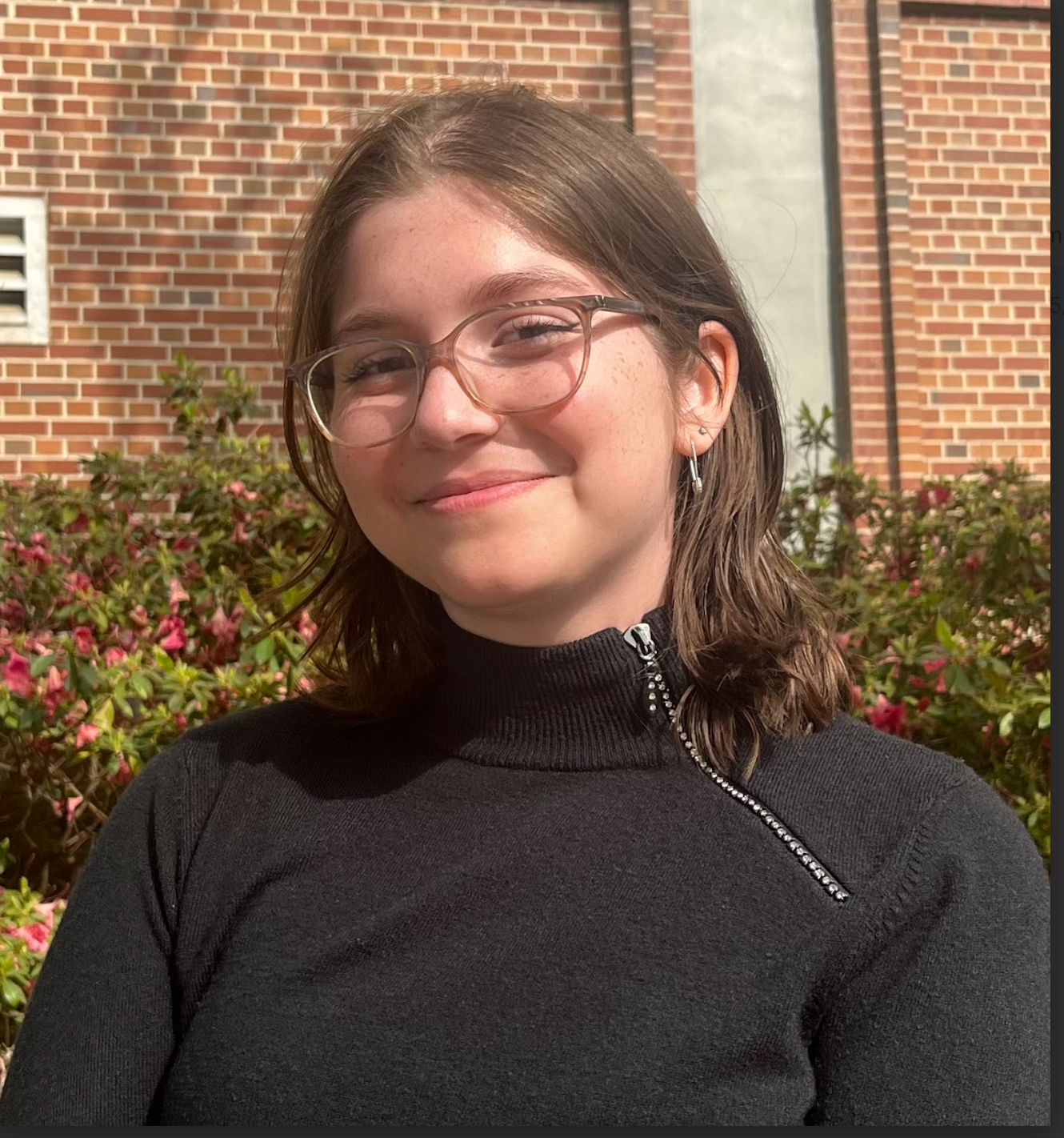
BIO
I'm currently a sophomore here at Florida State University, where I am to further my understanding in history and politics.
Rosenstrasse (2003) and the Battle Over Historical Interpretation of the Rosenstrasse Protest
Authors: Leilani Fries, Nathan StoltzfusStudent Major: History and Political Science
Mentor: Nathan Stoltzfus
Mentor's Department: Department of History Mentor's College: College of Arts and Sciences Co-Presenters:
Abstract
During the Nazi regime, those that were stuck in the middle betweem the categorizations of Jewish and Aryan relationships (Mischling) found themselves in a unique position in Nazi Germany. On February 27, Intermarried Jewish men were taken by the SS and detained with intent for deportation; in response, their wives protested on Rosenstrasse for seven days.
However, this historical interpretation of the Rosenstrasse Foundation is contested. Many argue that the Aryan wives’ protest did not free their husbands, as the regime never intended to deport these men in the first place. This historical debate culminates in the creation of the Rosenstrasse (2003) movie. While the final draft of the Rosenstrasse (2003) touted the “anti-protest” historical position, upon analyzing the first draft it becomes clear that a different historical interpretation was originally intended. This research project aims to determine why this historical interpretation was chosen by comparing these two Rosenstrasse (is enough) movie drafts. First by creating a “neutral” timeline of events of the Rosenstrasse protest, we will compare how these two drafts diverge in their historical interpretation. By doing this, it can be concluded that the intention of the final Rosenstrasse (2003) script was to create a more entertaining movie rather than an accurate historical recounting.
Keywords: history, Rosenstrasse, movie
24th annual Undergraduate Research Symposium, April 3, 2024
German Navarro Poster Session 1: 9:30 am - 10:30 am /253
BIO
My interests include clinical and developmental psychology. I plan to pursue something in therapy or counseling. Psychology as a whole really interests me because it allows me to understand myself and others around me better. I believe adding to the existing body of research in psychology is imperative for later generations.
Correlating Depression, Anxiety, and Stress with Spatial Navigation
Authors: German Navarro, Dorota Kossowska-KuhnStudent Major: Psychology
Mentor: Dorota Kossowska-Kuhn
Mentor's Department: Psychology Mentor's College: Arts and sciences Co-Presenters: Zach Helms
Abstract
Background: Depression, anxiety, and stress can significantly impair cognitive functioning, leading to difficulties in concentration, memory retrieval, decision-making, spatial navigation, and overall mental clarity. Existing literature suggests that individuals diagnosed with depression exhibit compromised navigational abilities, while children experiencing anxiety demonstrate impaired spatial orientation. This points to a potential association between clinically diagnosed anxiety and depression and deficits in spatial navigation and orientation (Zafar et al., 2023).
Methods: The present study aims to investigate correlation between spatial navigation skills and scores on the DASS21, a self-report questionnaire designed to gauge the severity of core symptoms related to Depression, Anxiety, and Stress. Spatial skills will be assessed using the Spatial Orientation Test (SOT) and Directions & ORienting Assessment (DORA). We plan to recruit 45 younger and 45 older adults.
Results: This study is currently ongoing, with an anticipated conclusion in April 2024. We hypothesize that individuals with higher scores on the DASS21 will perform less effectively on spatial navigation tests, irrespective of age and gender.
Keywords: Depression, Spatial Navigation, Aging,stress
24th annual Undergraduate Research Symposium, April 3, 2024
Aishat Lawal Poster Session 3: 1:30 pm - 2:30 pm /291
BIO
Aishat Lawal is a first-year Presidential Scholar at Florida State University pursuing a dual degree in English Literature and Theatre with minors in Film Studies and French. Aishat plans to use her undergraduate education to pursue careers in dramaturgy, theater division, and creative writing with an intercultural focus. Ultimately, Aishat plans to use her education and the power of words and storytelling to connect communities across figurative and geographical barriers.
Cocoa in the Dark: Film Festival Strategy and Understanding the Film Market
Authors: Aishat Lawal, Ryan Hope TravisStudent Major: English and Theatre
Mentor: Ryan Hope Travis
Mentor's Department: Theatre Mentor's College: Fine Arts Co-Presenters:
Abstract
Social justice films cater to a particular subset of film festivals, and uncovering the best-fit festivals gives this genre of film the best chance at a wide reach and a successful release. Professor Ryan Hope Travis’s film Cocoa in the Dark grapples with themes of wrongful incarceration and racial injustice in the prison industrial complex. In the film, a man wrongfully charged with rape is wrongfully sentenced to several years in prison, and is forced to come face to face with the ways in which the justice system continues to fail people of color. Together with the filmmaker, the research assistant will create a database of film festivals, highlighting those that prioritize themes of allyship and uplifting voices of directors of color, for the distribution of his feature film. Creating this database will be indispensable in helping the film reach its target audience as well as create a more efficient distribution plan for Travis.
The film festival selection process is lengthy, and it requires those hosting the festival to sift through thousands of submissions before programming a select few films into the festival’s run. By carefully noting which festivals have a proclivity for choosing films with themes of racism, injustice, and class, we can ensure the film’s success (as measured by how many festivals it is selected to be showcased in).
Keywords: film, social justice, actvism, filmmaking, film festivals
24th annual Undergraduate Research Symposium, April 3, 2024
Ana Rodriguez Poster Session 4: 2:45 pm - 3:45 pm /364

BIO
Hello, I'm Ana Rodriguez Santos, with roots in Cuba and a heart shaped by Miami. Currently studying cell and molecular neuroscience on the pre-med journey, my passion lies in unraveling the mysteries of biochemistry, particularly delving into protein structures using NMR.
Purification of LA-Related Protein 7 for Biophysical Characterization
Authors: Ana Rodriguez, Nolan BlackfordStudent Major: Cell and Molecular Neuroscience
Mentor: Nolan Blackford
Mentor's Department: Biophysics Department Mentor's College: Biophysics Department Co-Presenters:
Abstract
LARP-6 is an RNA binding protein that is responsible for the regulation of type I collagen. LARP-6 can regulate collagen production through post-transcriptional regulation by binding to the mRNA before translation takes place. In Fibrotic diseases, a buildup of collagen is observed in the body. Here we used recombinant protein expression to produce LARP-6. We joined together the DNA code of t-RNA and the DNA code of LARP-6 in a plasmid and using PCR we expressed many copies to study its interaction with the mRNA. This research used different techniques such as Nuclear Magnetic Resonance and Cryogenic electron microscopy to observe how LARP-6 and RNA bind together. Understanding how LARP-6 and RNA bind together to control collagen production can help us understand how to prevent the buildup of collagen in people with fibrotic diseases.
Keywords: NMR, LARP-7
24th annual Undergraduate Research Symposium, April 3, 2024
Sydney Mock Poster Session 5: 4:00 pm - 5:00 pm/270
BIO
I am a current sophomore Biology student here at Florida State University. I am hoping to attend pharmacy school and work in research and development in pharmaceuticals.
Descriptive Database for the Field of Collegiate Recovery Programs
Authors: Sydney Mock, Chelsea ShoreStudent Major: Biology
Mentor: Chelsea Shore
Mentor's Department: Collegiate Recovery Program Research Lab Mentor's College: Association of Higher Education Co-Presenters: Zane Reese, Vivan Gobler, Daniel Jordana, Roxie Richbourg, Anne Marquardt
Abstract
A scoping literature review conducted by N. Vest et al. (2021) revealed a noteworthy deficiency in available evidence pertaining to Collegiate Recovery Programs (CRPs). A thorough search conducted up to August 2020 yielded only 54 articles meeting stringent criteria. Addressing this gap, Dr. Chelsea Shore, supported by the Association of Recovery in Higher Education (ARHE), established an online descriptive database designed to assist collegiate recovery program providers and collegiate administrators. This database has over 100 (N=122) meticulously analyzed articles related to CRPs and college student recovery from substance (mis)use. Articles are systematically categorized by Author, Journal, Year, Title, Methodology, Analyses, Key Findings, SJDEI Topics, Theories, and Integrated Behavioral Health Areas, ensuring its utility as a comprehensive and structured resource for advancing research. This database aims to guide practitioners in the field of Collegiate Recovery, facilitating the development and improvement of CRPs within higher education institutions (HEIs).
Keywords: Addiction, Recovery, Recovery Programs
24th annual Undergraduate Research Symposium, April 3, 2024
Alexis Wilson Poster Session 1: 9:30 am - 10:30 am /144

BIO
Hi, I'm Alexis. I am a senior psychology major graduating this Spring, and I hope to pursue a career in counseling after I complete graduate school. I am from Palm Coast, Florida and plan on moving back to the East Coast after I finish school.
The Morphological Analysis Pathway to Reading in Multilingual Learners
Authors: Alexis Wilson, Dr. Carla WoodStudent Major: Psychology
Mentor: Dr. Carla Wood
Mentor's Department: Communication Science and Disorders Mentor's College: College of Communication and Information Co-Presenters: Sarah Quinlivan, Aribah Rana, Kara Adamczyk
Abstract
•Many educators struggle to keep up with the unique needs of the growing population of English learners who are simultaneously attaining academic skills and language proficiency through elementary education. Thus, it is vital that educators build a child’s morphological awareness at a young age, breaking the otherwise gap in their literacy proficiency.
•Morphological awareness can be defined as the understanding of how we comprehend the ability for all words to be dissected into smaller units like roots and prefixes.
•While many different approaches can be taken to improve reading comprehension, in both English and Spanish speaking children, the Morphological Analysis Pathway to Reading (MAP-R) seems to be an effective method for remedying the aforementioned knowledge and academic vocabulary.
•Following a five- year period funded by the U.S. Department of Education using a technology-based approach in delivering literacy instruction for multilingual elementary aged students with or at risk of learning disabilities, we hope to improve the Florida curriculum and delivery of instruction.
Keywords: Communications, Children, Reading Comprehension
24th annual Undergraduate Research Symposium, April 3, 2024
Rebecca Valentin Poster Session 4: 2:45 pm - 3:45 pm /192
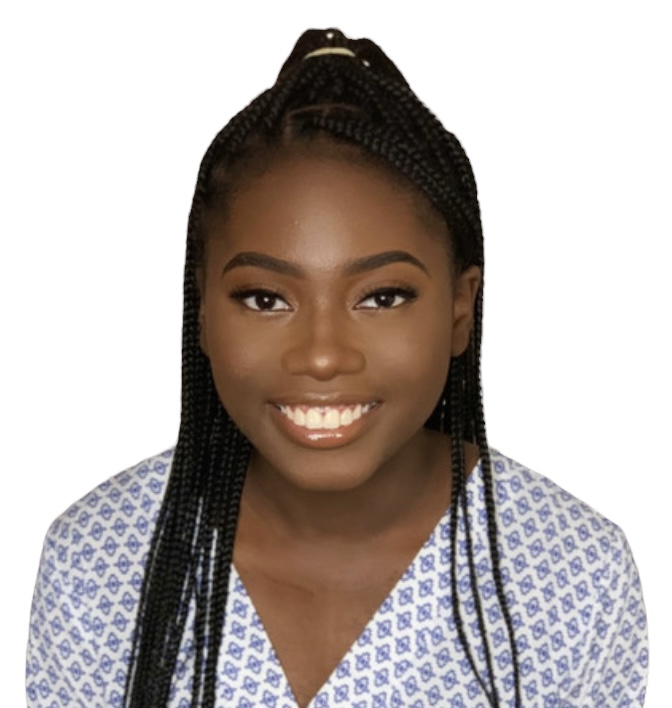
BIO
Hi! My name is Rebecca Valentin and I am a second-year student majoring in Interdisciplinary Medical Sciences: Clinical Professions. I aspire to become an Obstetrician-Gynecologist (OB/GYN), so I knew I would like to do research with mother and baby. I was lucky enough to be able to find and be accepted into Dr. Jessica Ridgway-Clayton's research on apparel for NICU moms. When I am not doing research, I am proud members of the National Society of Black Women in Medicine and the Caribbean Student Association.
Exploring Apparel Options for Working NICU Mothers: Development of a Breastfeeding Garment
Authors: Rebecca Valentin, Dr. Jessica Ridgway ClaytonStudent Major: Interdisciplinary Medical Sciences: Clinical Professions
Mentor: Dr. Jessica Ridgway Clayton
Mentor's Department: Retail Entrepreneurship Mentor's College: Jim Moran College of Entrepreneurship Co-Presenters: Abigail Golden
Abstract
In a mother’s postpartum journey with her newborn, kangaroo care and breastfeeding are influential factors for both their physical and mental health. Kangaroo care is skin-to-skin contact between mother and infant. Especially in the neonatal intensive care unit (NICU), this form of care is crucial as the NICU babies require additional medical support to become healthy. There are several barriers that mothers encounter in the NICU that make it difficult to perform kangaroo care and breastfeeding. For instance, there are very few garments that are available to mothers in the NICU that help them facilitate kangaroo care and breastfeeding. Since the majority of the infants in the NICU are low birth weight, they do not fit into the garments provided. In addition, the garments are uncomfortable for the mothers to wear after surgery or do not accommodate for the several wires attached to the infant. In order to find a garment that would best aid the mother and infant, mothers who have had their babies in the NICU, neonatal nurses, and lactation consultants were interviewed. The interviews were transcribed and coded to determine what the overlapping themes and desires of mothers were. It was discovered that many mothers wanted something that looked normal, breathable, and easy to remove. By understanding what mothers want, a breastfeeding garment that will provide comfort and support can be made.
Keywords: NICU, breastfeeding, baby


